

Norway In October: The Ultimate October Guide
October is kind of a transition month in Norway, and acting as a late autumn in some years and early winter in others. It’s among the least popular months to visit Norway as a tourist, but Norway in October is still incredible in it’s own way!
If you’re looking to see the most popular tourist attractions without standing in queues or being in a crowded space, October is the month for you! But just let me warn you, you will need to find your winter clothes when visiting Norway in October, because it’s getting pretty cold at this point.
Let’s take a look at Norwegian in October, from what to do, where to go, and of course the best inside information to making your October visit a success.
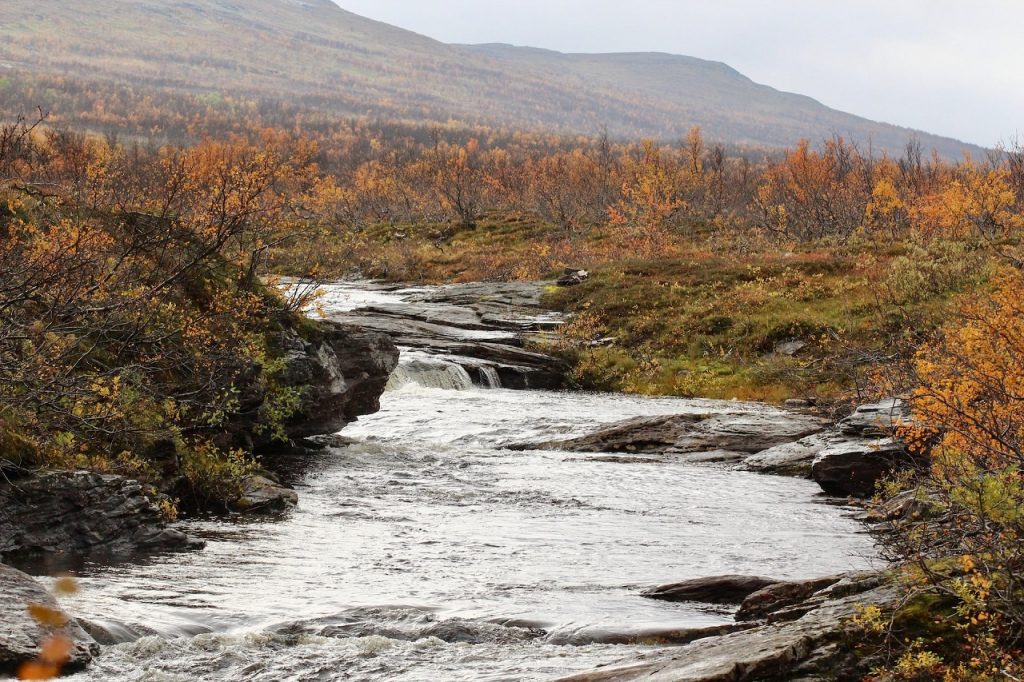
The weather in Norway in October
October is the first month that begins to be pretty cold in Norway . Just forget about wearing a t-shirt outside, and rather focus on finding good and warm clothing.
The average temperature will vary a lot in Norway in October, and begin much warmer at the start of the month than it is at the end.
There will also be a very big different between the south and north of Norway, and you will need more winter clothing if you are travelling to Tromsø or even further north.
You will definitely want to check the weather forecast before going out in October, especially if you are leaving for a hike or day trip that will be mostly outside.
You might get to experience snow in Norway in October , but it’s not going to be a winter wonderland with a big snow cover just yet. The flow of it tends to be that it snows in the late evening, night or early morning hours, then melt away during the day.
Let’s take a look at the expected temperatures and the weather for some popular cities in Norway in October.
The weather in Oslo in October
Oslo is the biggest city (as well as the capital) of Norway, and attracts hundreds of thousands of tourists every month, even in the off-season in October. There is typically no snow or anything like that this far south in Norway, but you might get lucky and get some snow in the night time.
Expect the temperatures to be between 7°C (44 °F) and 12°C ( 53 °F ) in the middle of the day, but around 0 – 2°C (32 – 36 °F ) in the night time .
This means that there will be frost on the ground, so be careful when going outside in the early morning hours. It might just be slippery!

The weather in Bergen in October
Bergen is well known for its rain, and October is no exception. There are one average 15 days of rain in Bergen in October , so pretty much half of the days will be rainy!
The temperature is not quite as cold as most other parts of Norway due to Bergen’s proximity to the ocean, and it’s typically between 7 and 9 °C in the night, and between 9 and 13 °C in the day.
It’s not going to be anywhere close to freezing temperatures, so there’s no need to prepare for snow in Bergen in October. Sorry, but it’s just not going to happen!

The weather in Tromsø in October
If you’re visiting Tromsø in October, be prepared for a wet visit. It won’t be many rainy days, but you are statistically likely to see a lot of snowfall .
The average temperature is typically between -5 and 0 °C in the late evening, at night or in the early morning hours, and just above freezing in the day. This means that most of the rainfall will come down as snow, but it will usually melt in the daylight.
This leads to a lot of slushy ice, to bring winter boots or waterproof shoes!
It’s also worth mentioning that Tromsø will have only 5 to 6 hours of daylight per day in October, so it’s beginning to get dark. However, this also leads to some amazing opportunities for the northern lights, but we will get back to this topic later on in the article.
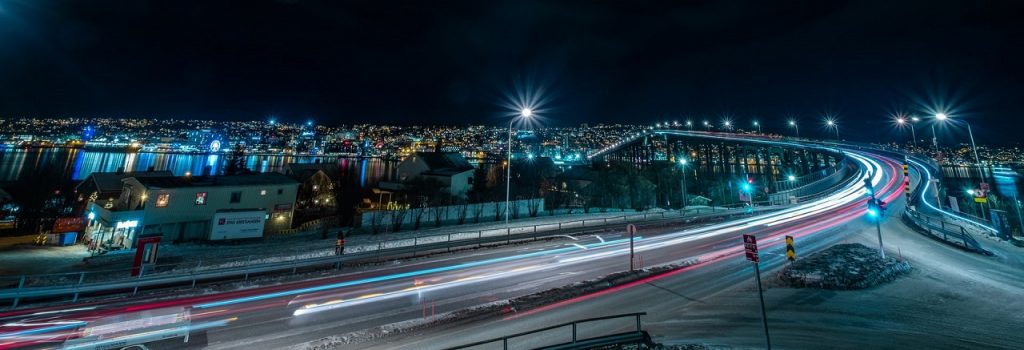
Hiking in Norway in October
Many tourists come to Norway to hike, either for recreation or to see some of the incredible natural wonders like Trolltunga or Pulpit Rock. But what’s the hiking like in Norway in October?
Hiking in the mountains in October is typically much more challenging than in earlier months, due to the risk of there being frost and small patches of ice on the ground.
This makes trails more slippery, and increases the need for good equipment. Even at good trails in the mountain, you are likely to encounter patches with frost and slippery rocks.
That said, it’s perfectly possible to go hiking in Norway in October, but bring waterproof and warm clothing (we recommend wool under-layers) even this early in the winter.
Some trails are closed in October due to chance of snowfall. This includes the famous Trolltunga hike which closes at September 30.

And the same principle as the weather applies; further into the month and further north will make it more likely to experience frost, ice or even snowfall.
It’s not really a problem to hike in the mountains for most of October, but be prepared to take it easy.
Shorter hikes in the forest or lowlands are perfectly nice in October, and the color palette makes it an incredible time to go exploring the amazing nature.
There are thousands of shorter hikes all over Norway, and October is just amazing if you just want to go on trails without planning on going high up in the mountains.

Should you expect crowds in October?
October is typically considered the off-season for tourism in Norway, both for foreign tourists as well as Norwegian tourists. Summer season is long gone, but the winter skiing season has yet to start, so you’re right in the sweet spot.
In other words, there are very few crowds in Norway on October!
This is great for those of you that don’t want to be stuck in long queues to get to see pieces in the museums or get stuck in a line when hiking at the popular trails.
It should be fairly easy to find accommodation, and it’s also likely going to be pretty cheap since most places will have many spare rooms available.
That said, I urge everyone to book accommodation online before arriving in Norway. This will save you some money and time, and make sure that you actually have a place to spend the night.
Seeing the aurora borealis in October
You can often be able to see the northern light (aurora borealis) in northern Norway in October, especially in the last half of the month.
You will have to be a bit lucky to see the northern lights in October, but there are a few things you can do to increase your chances of seeing the northern lights:
- Check out the aurora borealis forecast to find a good night.
- Go far away from the city to reduce any light pollution.
You will typically want to be in Tromsø or even further north to have a decent chance of seeing the northern lights as early as October, but it’s absolutely possible.

Camping in Norway in October
Many people opt to use the free camping as a means of making their visit to Norway a bit cheaper , but it’s important to keep in mind that it will get very cold to spend the night in a tent in October.
It’s not a big problem as long as you got decent camping equipment such as a good sleeping pad, but it does absolutely require good equipment in October and later.
Winter wild camping is not for beginners, and camping in October is just on the edge of what beginner campers can handle without putting their safety at risk.
Most campsites in Norway are long closed by October, so your only option left is to go wild camping in nature.
I recommend not to go wild camping in Norway in October unless you are absolutely sure that you can handle it.
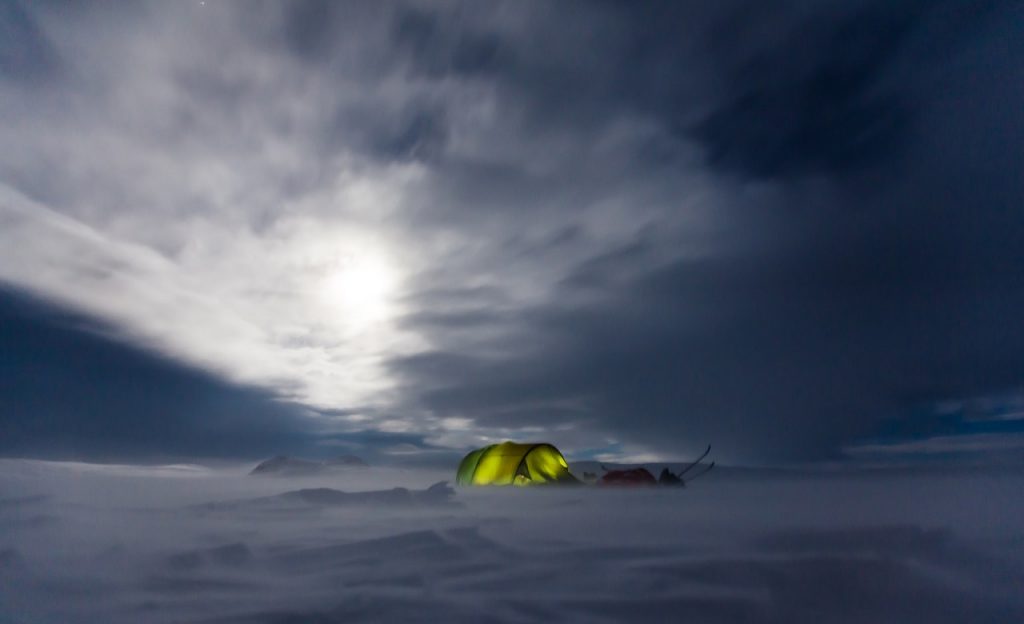
What Norwegians typically do in October
Norwegians typically use October to take it easy, and enjoy time indoors. It’s getting colder and darker outside, so Norwegians often combat this with what we call “ kos “, which can be translated to cozy, but also means so much more.
Families with cabins will use October as a good opportunity to spend a lot of time there. The cabin will be a base for hiking, picking cloudberries , and to eat incredible meals. We often see cabins that are owned by entire families, so you have both grandparents, the adults and children in the same cabin, spending time together across generations in the weekends.
Some people own modern cabins with saunas, hot tubs and everything you find in regular houses, while others opt for more traditional cabins without electricity.
You can easily rent cabins as a tourist , but they will be pretty pricey in October.

October is often a lazy month for Norwegians , and we tend to use this time to just focus on the day to day activities like school or work, and just enjoying that for the month until the pre-Christmas season kicks in at the beginning of November.
Visiting the Norwegian fjords in October
Many people are asking if you are able to visit the fjords in Norway in October, and you most certainly are!
October is a great time to visit the Norwegian fjords, and you will be surprised by it’s late autumn beauty.
The fjords are still incredible in October, and it’s just something magical about seeing the brown and orange on the mountainsides rising from the fjords.
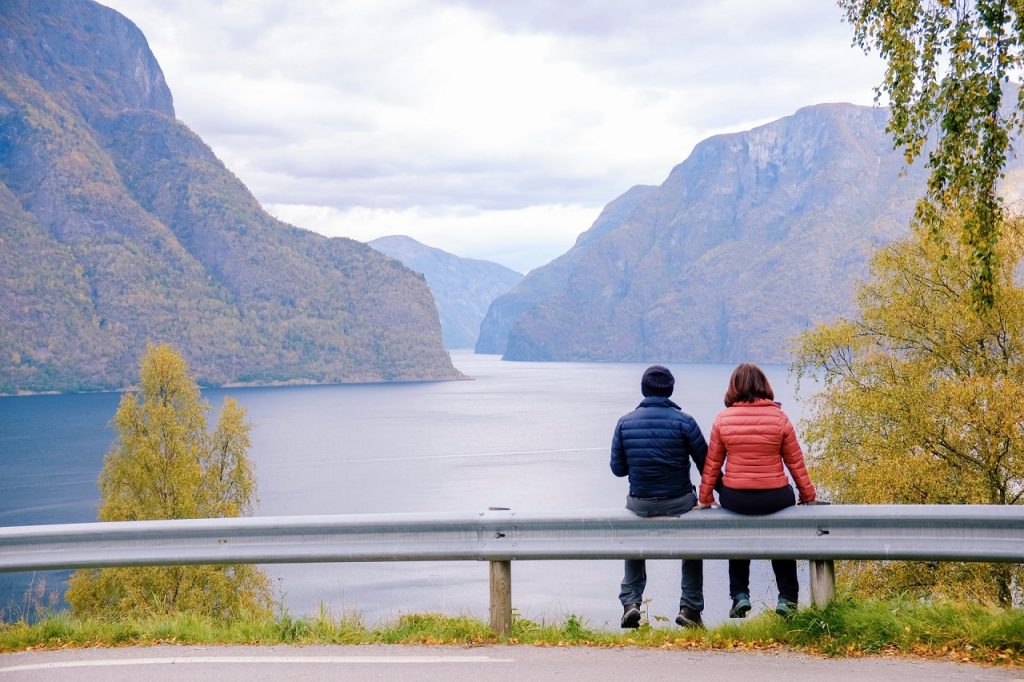
Events in Norway in October
October is not really a month where a lot of stuff happens in Norway, but there are a few festivals and events to be aware of:
- Insomnia Festival . The Insaomnia Festival is in Tromsø, and features electronic music.
- Lillehammer Jazz Festival. This 4 day long festival in Lilehammer features a lot of jazz bands and artists, and makes for an unforgettable experience.
- Oktoberfest . This beer festival originally originate from Germany, but Norwegians love beer, so it’s becoming more and more common to have a public Oktoberfest in most big cities in Norway.
Frequently asked questions about Norway in October
Below are some of the most common questions we get asked about visiting Norway in October, so hopefully you will find all you need to know there. And if not, let us know in the comment sections, and we will make sure to answer with what you need to know!
What is the weather like in Norway in October?
The weather tend to be rainy or clouded with a small chance of some snowfall during most of October.
Can you go skiing in Norway in October?
It’s usually a bit too early to go skiing in Norway in October, but it’s possible in a few locations far north such as in the Lyngen Alps.
How cold in Norway in October?
Southern Norway will typically have temperatures between 7°C (44 °F) and 12°C (53 °F) in the daytime, and around 0 – 2°C (32 – 36 °F) at night.
Is October a good time to visit Norway?
It really depends on what you expect, but it is a great time to visit if you don’t want crowds and are OK with colder temperatures . Just bring enough clothes, and you will have a great time in Norway in October.
Do Norwegians celebrate Halloween?
Halloween is a pretty new tradition in Norway, and you can think of it as a scaled down version of the American celebration. It’s mostly younger people who uses it as an opportunity to party and dress up, but children might come to trick or treat in the cities.
And as you can expect, Halloween is celebrated on the last day in October.
Is there snow in Norway in October?
There can be nights with snowfall in Norway in October, but the snow will most usually disappear in a few hours when day begins. The first real snowfall that stays on the ground tends to be in late November.
The further north you are, the higher the chances of seeing snowfall is.

Norway monthly travel guides
This is far from the only monthly guide to Norway we have in store, so check out the other months below if you are interested in visiting Norway in the future.
- Norway in January (Coming soon).
- Norway in February (Coming soon).
- Norway in March (Coming soon).
- Norway in April (Coming soon).
- Norway in May .
- Norway in June .
- Norway in July .
- Norway in August .
- Norway in September .
- Norway in October .
- Norway in November .
- Norway in December .
2 thoughts on “Norway In October: The Ultimate October Guide”
This was very informative. Taking a cruise in October. Hopefully we will see the northern lights. We will be stopping overnight in Tomoso.
I’m glad you liked the article!
And best of luck with seeing the northern lights 🙂 You will need a bit of luck since you’re only there for a single night, but it’s definitely possible if the weather and aurora plays along.
Best regards Nicklas
Leave a Comment Cancel reply
Save my name, email, and website in this browser for the next time I comment.
The Best Time to Visit Oslo – and When to Avoid it!

Oslo; it’s the land of hygge, beautiful fjords, and thriving nature. It’s a city of many faces. To some, the perfect destination for a romantic weekend getaway; to others, it’s the ideal place to spend an action-packed summer holiday. To me? Well, it’s a bit of both.
Travelers come from all over the world to experience Norway’s Viking capital, but there’s one question on everyone’s mind – when exactly is the best time to visit? The answer, unfortunately, is not so simple. Oslo is a city that experiences all four seasons, and each has its own unique charm.
The good news is that there really is no wrong time to visit Oslo. But, depending on what you’re looking for in a vacation, there are certain times of year that are better than others. To ensure you make the most of your trip, I’ve put together the ultimate seasonal guide to the best (and worst) times to visit Oslo.
Read on to find out when is the best time for you to travel to Norway’s picturesque capital city!
Hint: See if you can figure out what the missing month is!
You might also like: My Top Hotel Recommendations for Bergen
Fall ( Mid-August – October)

Say hello to crisp air, beautiful autumn colors, and long walks along the Aker River. Fall is a wonderful time to visit Oslo if you’re looking to escape the crowds but still enjoy all the city has to offer.
There are significantly fewer tourists than in peak season, which means shorter lines at attractions, cheaper accommodation rates, and a more authentic experience overall. Just be sure to pack a jacket – the weather can be unpredictable!
You might also like: One of My Favorite Hotels in Oslo
The fall season may start in mid-August or early September. The average fall temperature is +12C, but it begins to get even colder as October approaches. There’s no doubt that some of the most beautiful months in Oslo, Norway, are September and October, when the sky often glows in warm hues, the air is crisp, and leaves start to turn yellow.
Best things to do in Oslo during the Fall season:
● Visit the Oslo Opera House – One of Oslo’s most iconic buildings, the Opera House is worth a visit even if you don’t plan on seeing a show. The sloping white exterior is made from Italian marble and granite, and offers incredible views of the surrounding fjord. The Opera House is free to visit, but tours cost 120 kroner (about $15) for each adult and 70 kroner (around $8.50) for children between the ages of 4 and 16. Oslo Passholders get a discounted rate.
● Appreciate Art and Nature at Vigelandsparken ( Frogner Park ) – This is one of the most famous landmarks in Oslo, with thousands of people uploading photos of the sculptures in the park every year. It has more than 900 distinct works of art by Norwegian sculptor Gustav Vigeland, making it the world’s biggest sculpture park. It’s a beautiful spot to spend an afternoon, especially in September when the roses are in full bloom. If you visit in October, you’ll be able to see the leaves changing color.
● Explore the VÍKINGR – This is an immersive exhibit that transports visitors to the Viking Age and immerses them in the daily life of Vikings. See if you can spot the Gjermundbu helmet while you’re there, it’s the best preserved Viking helmet in the world! Check out my previous article to learn more about this incredible exhibition.
● Hiking in Nordmarka – Nordmarka is Oslo’s green lung, and it’s the perfect place to escape the hustle and bustle of the city. There are numerous hiking and biking trails to explore, but you’re also sure to find a quiet spot to relax. The hiking trails in Nordmarka are usually well-marked, but a map is recommended for lengthier stretches.
● Sample Norwegian Comfort Food – Kjøttkaker (meatballs) , Pølse i Lompe (hot dog in a potato tortilla) and Vafler (Norwegian waffles) are just three of the many delicious Norwegian dishes you’ll find in Oslo. Be sure to also try out a shot of Aquavit – Norway’s national spirit!
Winter (December – Mid(end)-March

Photo: Michael Ankes – @w83design
Hibernation mode is real in Oslo during the winter months. From December until March, the city is often blanketed in snow, and temperatures hover around the freezing point. This might not sound appealing, but wintertime in Oslo, Norway, can actually be quite magical.
If you’re lucky enough to visit during the Christmas season, you’ll be treated to festive markets, twinkling lights, and gingerbread galore. However, even if you’re not visiting during December, winter is still a great time to experience Oslo’s unique culture. Ice skating, cross-country skiing, and sledding are just some of the fun activities you can enjoy in the snow.
Best things to do in Oslo during the Winter season:
● Visit the Christmas markets – One of the best things to do in Oslo during winter is to visit the Christmas markets. You’ll find them in various locations around the city. Expect to find handicrafts, gifts, and, of course, plenty of festive food and drink. Check here for 2022-2023 Christmas festival dates!
● Go Skiing, Sledding, or Skating! – Oslo is the perfect place to enjoy winter sports. There are several ski resorts within a day-trip distance, and cross-country skiing is also popular in the Oslo forest. If you’re looking for something a little more low-key, go ice skating at one of the city’s many rinks. Some of the most popular downhill ski resorts near Oslo include Winter Park, Tryvann, and Grefsenkollen ski slope. For cross country skiing start out at Sognsvann or Frognerseteren.
● Embrace Nature – Just because it’s cold outside doesn’t mean you have to stay indoors. One of the best things about Oslo is its proximity to nature. There are several parks and forests within the city limits, so you can easily escape into the wilderness for a day of hiking or cross-country skiing. Nordmarka is a particularly popular spot for outdoor enthusiasts.
● Hibernate With a Good Book – If you’re not a fan of the cold, you can always hibernate indoors with a good book. Oslo has many cozy cafes where you can relax with a cup of coffee and a good read. Deichmanske Bibliotek in Bjørvika is one of my favorite places to curl up with a book. It’s the city’s main public library, and it has an extensive collection of both Norwegian and international literature.
● Rent a Cabin or a Hotel room In the Snowy Oslo Forest – For a truly Norwegian experience, rent a cabin in the Oslo forest. There are many cabins to choose from, and they’re the perfect place to relax after a long day of skiing or hiking. It’s a truly magical experience, and it’s one you won’t soon forget.
From the Voksenasen Hotel , the cross-country ski trails of Oslomarka (the Oslo forest) are directly accessible from just outside the front door.
You might also like: My Top Hotel Recommendations for Bergen
Spring (April – Mid-June)

As the snow begins to melt and the days get longer, Oslo comes alive. The city is filled with blooming flowers, and the trees are starting to turn a lovely shade of green. Spring is the perfect time to visit if you’re looking for a more relaxed atmosphere. Easter is particularly lovely in Oslo, as many flock to the mountains.
The 17th of May is our national day and a big celebration in Oslo. The streets are filled with people in traditional dress, and there are parades and celebrations throughout the city.
If you’re planning a trip to Oslo in the Spring, be sure to pack your walking shoes. This is the perfect time of year to explore the city on foot, and you’ll have plenty of opportunities to take in that fresh flowery air. Spring is also an excellent time for outdoor activities, so don’t hesitate to get out and about. Hiking, biking, and kayaking are all popular activities in Oslo at this time!
Some of the best things to do in Oslo during the springtime include:
● Take a Boat Ride on the Oslofjord – As the weather gets warmer, the Oslofjord becomes a popular spot for boat rides. This is a great way to see some of Oslo’s best scenery; you’ll have the opportunity to see charming landscapes, fantastic city views, and the beautiful hills surrounding it. There are several boat tours to choose from, so you’re sure to find one that’s perfect for you.
Find cruises on the Oslo fjord here .
● Explore the Akershus Fortress – The Akershus Fortress is a must-see for any history buff. This medieval castle is one of Oslo’s most popular tourist attractions, and it’s definitely worth a visit. Be sure to explore the fortress grounds, as there is a lot to see.
● Visit the Munch Museum – The Munch Museum is one of Oslo’s most famous museums. This museum is home to a collection of paintings by Edvard Munch, one of Norway’s most renowned artists. You’ll also find several other artworks on display, and you’re sure to learn something new.
● Hike to Holmenkollen – One of the best things to do in Oslo is to hike to the top of Holmenkollen. This is one of Oslo’s most popular tourist attractions, and it’s definitely worth the effort. The views from the top are absolutely breathtaking, and you’ll have the opportunity to see some of Oslo’s best scenery. Oslo Hiking actively plans scenic trips in the area for whoever wants to join; you can book via their website for 75 euros.
● Kayak on the Oslofjord – As the weather gets warmer, the Oslofjord becomes a popular spot for kayaking. This is a great way to get some exercise, and you’ll have the opportunity to take in some of Oslo’s best scenery. Throughout it, you’ll see the beautiful city sights and wilderness highlights like bays, beaches, and islands. No prior kayaking experience is required.
Find available kayaking tours on the Oslofjord here.
Summer (Mid-June – Mid-August)

My personal favorite; Summertime. In Oslo, late Summer is often referred to as “sensommer.” The days begin to get longer, the weather is warm, and the city is filled with people enjoying the outdoors. This is the perfect time to visit if you’re looking for some fun in the sun. Swimming in the fjord, fishing, park life, staying up late, and enjoying the summer nights should all be on your to-do list.
In the Summer, you can pretty much do everything you can do in the Spring, but better. The weather is nicer, so you can enjoy all of the outdoor activities without worrying about the cold. This is also the busiest time of year for tourism, so be sure to book your hotel room in advance.
Some of the best things to do in Oslo during the summertime include:
● Swim in Oslofjord! – As the weather gets warmer, the beautiful fjord becomes a popular spot for locals and tourists alike. The fjord is incredibly clean and refreshing, and there are plenty of places along the waterfront to just dive right in! This is a great way to cool off, and you’ll have the opportunity to take in some of Oslo’s best scenery. You can find entrances either from the docks, or from some public beaches. There is one at Bygdøy, one next to the Opera House, or jump off the docks right next to the Astrup Fearnley Museum of Contemporary Art!
● Fjord Galore – Oslofjord is unsurprisingly lovely in the Summer. As I mentioned above, this is a great time to swim, but it’s also awesome for fishing, or just simply enjoying the views. On Oslofjord, you can also take a boat ride, kayak, or splish splash while taking in all of the beauty Oslo offers. Many people also enjoy taking the small ferries out to the islands for swimming and a BBQ!
● Visit the Norsk Folkemuseum Open-Air Folk Museum – The Norsk Folkemuseum, located on Bygdøy in Oslo, Norway, has one of the world’s most comprehensive collections of artifacts from all social classes and areas of the country. It also features a large open-air museum with more than 150 reconstructed structures from across Norway.
● Rooftop Concerts at the Opera – During the summertime, the Opera House hosts a number of rooftop concerts, which are a great way to enjoy some live music. Sit back and relax as you let the sweet sounds of the city wash over you.
You might also like: The Best Low Budget Hotel in Oslo
So, Did You Figure it Out?
If you remember correctly, I mentioned that there would be a missing month at the beginning of this post. Did you figure it out?
It’s November! But why November, you ask?
Well, in my opinion, it’s just not a great time to visit Oslo. The weather is starting to get colder, and the days are shorter. There are also fewer things to do, as many of the tourist attractions are closed for the winter. It’s cold, it’s dark, and it’s often raining. So, in my opinion, it’s just not worth it.
With that being said, if you would still love to visit Oslo and don’t want to wait until December or for the weather to get warmer, then you still have the option to embrace yourself in the history of it all. For example, you can check out two fantastic museums in Bygdøy:
● Kon-Tiki Museum : This museum is about the adventures of the famous explorer Thor Heyerdahl. The museum is located in a beautiful setting, and has plenty to see and do!
● Fram Museum : The Fram museum is also located in Bygdøy, and is a great place to visit if you are interested in the history of polar exploration. This museum has a lot to offer, including a huge ice-breaking ship called FRAM, as well as an impressive amount of artifacts!
You can also take a walk to the beautiful Oslo City Hall, where you can see architecture at its finest and take in the views of the city. Read all about Oslo City Hall in my previous blog, “ Visit the Oslo City Hall – A public living room .” Or, enjoy a Sauna by the fjord, which is a great way to relax and bond with your friends or family, and they’re open all year round! Check out my blog post Enjoy Sauna by the Oslo Fjord , to learn more about this remarkable experience.
If you’re looking for the best time to visit Oslo, I would recommend either Summertime or Wintertime. Both have their own unique charm, there is plenty to do, and the seasonal weather is perfect for enjoying all that the city offers.
Thanks for reading! I hope this ultimate seasonal guide has provided you with all the information you need to plan the perfect trip to Oslo. Happy and safe travels!
Traveling to Oslo soon? Check out my YouTube videos for visuals, and tips, and join me on my many adventures!
Your friend in Norway,

Pål of Norway With Pål
Norway native, veteran travel guide, sailor, filmmaker, and writer (you might have seen me in one of Rick Steves’ guidebooks!). I want to help you enjoy Norway the right way — like a local. Learn more about me.
DISCLAIMER: Products on this page may contain affiliate links, and I might make a small sum per purchase. For you this does not affect the product price, but supports me and my work, and makes me able to continue sharing my passion for Norway with you. Read the Disclaimer policy . Thank you, tusen takk!
Join on Patreon
Donate on paypal, watch on youtube.
Maybe we should come and stay for a year!!! but go away in November. LOL Actually your November sounds like our November – just not a fun month. I have to say this is a great article. Kudos to you. Ha en fantastisk Sommer!
haha that sounds like a great plan! I’m glad you enjoyed the article, tusen takk! Hope you’ll have en fantastisk sommer as well
I’ve been reading July is always overcast and very very rainy . Is they true ?
Usually in July there are both rainy and sunny days.
Leave a Comment Cancel Reply
Save my name, email, and website in this browser for the next time I comment.
Join the Newsletter

Get my digital recipe book with seven traditional and tasty Norwegian delights!
Your privacy is important to me. View my Privacy Policy.

Become a part of the virtual viking Norway With Pål family, support, and get exclusive content and perks!
Looking for something?
Norwegian culture, travel in norway, travel planning, countryside, norway travel tips, norwegian food, norwegian history, norwegian language, norwegian traditions, places to stay, things to do.

Your support helps me to continue sharing my passion for Norway with you. Tusen takk! Thank you!

Things to do in Oslo in October
Navigate forward to interact with the calendar and select a date. Press the question mark key to get the keyboard shortcuts for changing dates.
Navigate backward to interact with the calendar and select a date. Press the question mark key to get the keyboard shortcuts for changing dates.
Looking for a different month?
October is a good time to visit Oslo . The weather is usually cold, humid but cool, with temperatures ranging from 36—47°F (2—8°C). There are plenty of events to check out and activities to try in Oslo during this time. Some of our top recommendations: visit the Norwegian Museum of Cultural History and explore the open-air museum in the fall, go on a scenic hike in the Oslomarka forest and witness the fall foliage, take a scenic train ride on the Flåm Railway, and more!
Oslo has plenty to offer for visitors of all ages and interests. In this article, we tell you the top things to see and do for your October trip to Oslo. Get inspired by the events, activities, attractions, and experiences unique to October. We’ll let you know where to explore events based on your interests, whether that’s food, culture, art, music, sport or others.
We’ll let you know everything you need to prepare for the weather in Oslo in October. Learn about what to wear and pack for your trip, the average temperatures throughout October, temperature changes from morning to evening and much more.
Table of contents
- Experiences
- Weather and what to wear
- Attractions

Best events and things to do in Oslo in October
Top experiences in october, visit the norwegian museum of cultural history and explore the open-air museum in the fall, go on a scenic hike in the oslomarka forest and witness the fall foliage, take a scenic train ride on the flåm railway, explore the akershus fortress and enjoy the crisp autumn air, visit the viking ship museum and learn about norway's rich history, visit the oslo botanical garden and see the beautiful autumn foliage, take a boat tour of the oslo fjord and enjoy the autumn scenery, visit the munch museum and admire the works of edvard munch, holidays in oslo in october.
- Repentance Day ( October 27 )
Other notable holidays
- All Saints' Day ( November 3 )
- First Advent Sunday ( December 1 )
- Second Advent Sunday ( December 8 )
- Third Advent Sunday ( December 15 )
- Fourth Advent Sunday ( December 22 )
- Christmas Eve ( December 24 )
- Christmas Day ( December 25 )
- Boxing Day ( December 26 )
- New Year's Eve ( December 31 )
- New Year's Day ( January 1 )
- Carnival ( March 2 )
- Palm Sunday ( April 13 )
- Maundy Thursday ( April 17 )
- Good Friday ( April 18 )
- Weather in Oslo in October
Temperatures on an average day in Oslo in October
The average temperature in Oslo in October for a typical day ranges from a high of 47°F (8°C) to a low of 36°F (2°C). Some would describe it as cold, humid but cool.
For comparison, the hottest month in Oslo , July, has days with highs of 70°F (21°C) and lows of 53°F (12°C). The coldest month, January has days with highs of 25°F (-4°C) and lows of 16°F (-9°C). This graph shows how an average day looks like in Oslo in October based on historical data.
Visiting Oslo? See our Oslo Trip Planner.
Historical temperature average in October
General weather summary, what to wear in october, best attractions for oslo in october.

Popular road trips from Oslo
What's the weather like in oslo.
It depends on when you visit! We've compiled data from NASA on what the weather is like in Oslo for each month of the year: see the links below for more information.
- Weather in Oslo in January
- Weather in Oslo in February
- Weather in Oslo in March
- Weather in Oslo in April
- Weather in Oslo in May
- Weather in Oslo in June
- Weather in Oslo in July
- Weather in Oslo in August
- Weather in Oslo in September
- Weather in Oslo in November
- Weather in Oslo in December
All road trips from Oslo
- Oslo to London drive
- Oslo to Paris drive
- Oslo to Berlin drive
- Oslo to Rome drive
- Oslo to Amsterdam drive
- Oslo to Copenhagen drive
- Oslo to Barcelona drive
- Oslo to Stockholm drive
- Oslo to Prague drive
- Oslo to Vienna drive
- Oslo to Budapest drive
- Oslo to Florence drive
- Oslo to St. Petersburg drive
- Oslo to Edinburgh drive
- Oslo to Milan drive
- Oslo to Venice drive
- Oslo to Dublin drive
- Oslo to Brussels drive
- Oslo to Munich drive
- Oslo to Hamburg drive
- Oslo to Moscow drive
- Oslo to Bergen drive
- Oslo to Krakow drive
- Oslo to Helsinki drive
- Oslo to Tallinn drive
- Oslo to Gothenburg drive
- Oslo to Naples drive
- Oslo to Turin drive
- Oslo to Warsaw drive
Explore nearby places
- Finstadjordet
- Fjellstrand
- Skedsmokorset
All related maps of Oslo
- Map of Oslo
- Map of Lysaker
- Map of Fornebu
- Map of Stabekk
- Map of Osteras
- Map of Bekkestua
- Map of Hovik
- Map of Lorenskog
- Map of Kolbotn
- Map of Sandvika
- Map of Sofiemyr
- Map of Finstadjordet
- Map of Hagan
- Map of Nesoya
- Map of Strommen
- Map of Oppegard
- Map of Skjetten
- Map of Rykkinn
- Map of Voyenenga
- Map of Fjellstrand
- Map of Nesbru
- Map of Lommedalen
- Map of Hvalstad
- Map of Lillestrom
- Map of Fjerdingby
- Map of Skedsmokorset
- Map of Vollen
- Map of Vinterbro
- Map of Asker
- Map of Borgen
Oslo throughout the year
- Oslo in January
- Oslo in February
- Oslo in March
- Oslo in April
- Oslo in May
- Oslo in June
- Oslo in July
- Oslo in August
- Oslo in September
- Oslo in October
- Oslo in November
- Oslo in December
Looking for day-by-day itineraries in Oslo?
Get inspired for your trip to Oslo with our curated itineraries that are jam-packed with popular attractions everyday! Check them out here:
- 1-Day Oslo Itinerary
- 2-Day Oslo Itinerary
- 3-Day Oslo Itinerary
- 4-Day Oslo Itinerary
- 5-Day Oslo Itinerary

- Itinerary + map in one view
- Live collaboration
- Auto-import hotels and reservations
- Optimize your route
- Offline access on mobile
- See time and distance between all your places
Travel Reservation Hotline
Call and book your hotel now.
Domestic Toll-Free for US and Canada: 1-800-997-1438
Worldwide: +1-817-983-0682
- Parks and Wildlife
- Sightseeing
- Theatre and Dance
- Restaurants
- Exhibitions
- Travel Tips
- Feature Your Business
- Top Things To Do
- Hot Sellers
- Outdoor Activities
- Walking & Biking Tours
What to do in Oslo this October
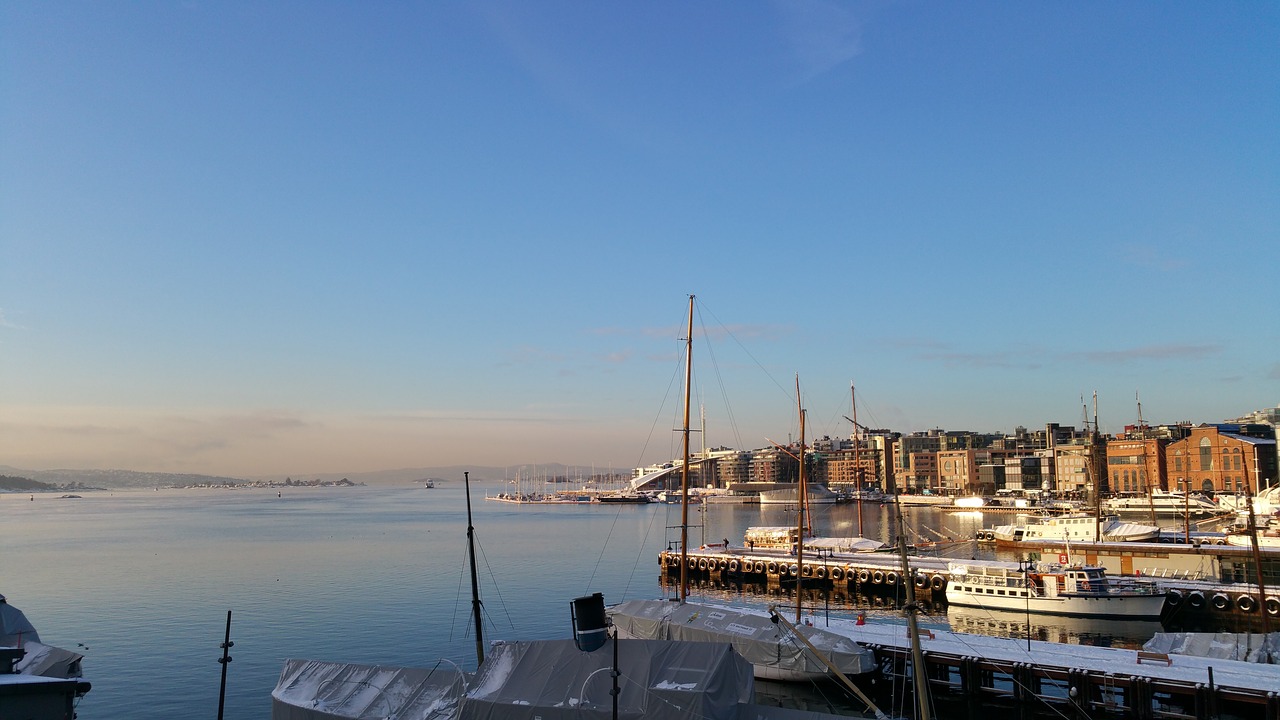
Take advantage of the chilly autumn colours in October as winter rolls in, bringing with it crisp, cool air and shorter daylight hours. Temperatures usually range between 4ºC and 10ºC (40ºF and 50ºF). Northern parts are usually colder and the weather can change quickly so make sure pack some warm woollies and outdoor winter gear, also to carry shoes that will let you traverse snow.
In October, Oslo is relatively uncrowded so one can go out and enjoy some fresh air while spending time in places like Vigeland Sculpture Park or exploring Oslo's Akerselva River Walk—a scenic 5-mile waterway with forests, wildlife, museums, and local history. Most of Norway’s urban areas are located close to nature so there are several hiking trails one can discover. Autumn also sees Oslo host a number of art exhibitions, local harvest and literature festivals as well as small indoor concerts.
Events to Attend
Lillehammer Jazz Festival
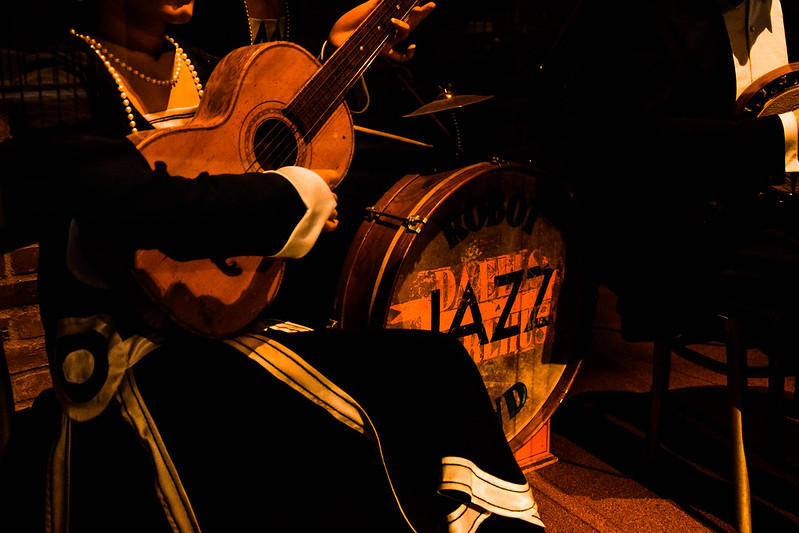
Credit: Flickr / Maria Eklind / CC BY-SA 2.0
An annual Jazz festival in Norway that brings down renowned local and foreign performers. Catch some amazing Norwegian and Nordic jazz as you catch veterans and young talent. The festival aims to be a platform for budding talent, often in collaboration with education institutes in the fields of music and visual media.
Oktoberfest Continues
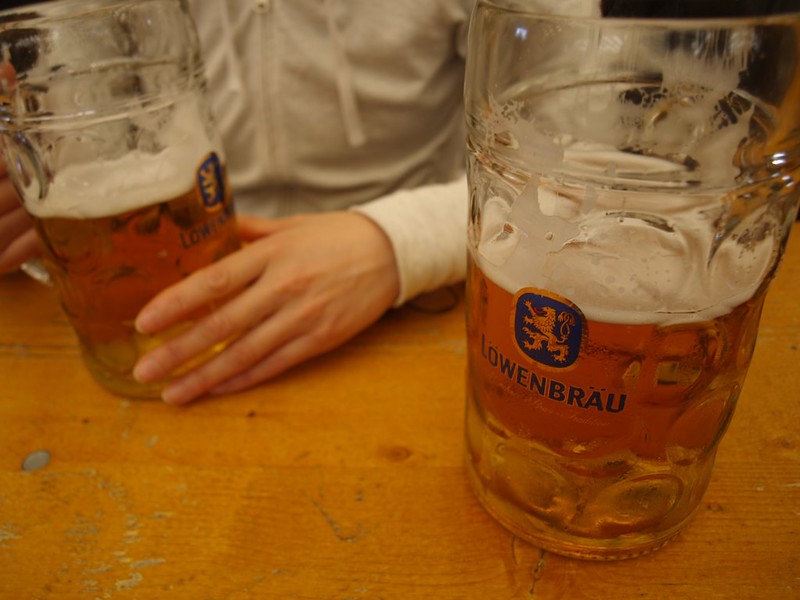
Credit: Flickr / Jon Blathwayt / CC BY 2.0
Oktoberfest might be over for most of the world, but the party continues at Youngstorget . Visit them on 11th, 12th, 17th and 19th October for a day party. Enjoy the sound of our Tyrolean Orchestra «Ronald Schnipfelgrüber Tyrolerkapelle» filling the tent day after day, while you and your friends sit side by side and experience a true Bavarian atmosphere. Doors open at 3:00 pm on weekdays and 12:00 pm on Saturdays with seating available on a first-come, first-serve basis. Enjoy scrumptious sharing platters made up of pork knuckles, Wurst, neck chops, chicken, sauerkraut, potato salad, courtesy of Strøm Larsen. For those of you who have not reserved food, a separate food court may be found inside the tent. There you can get various Wurst, chops, cured meats, popcorn, etc.
Leave a Reply

- What to do in Oslo in October 2024
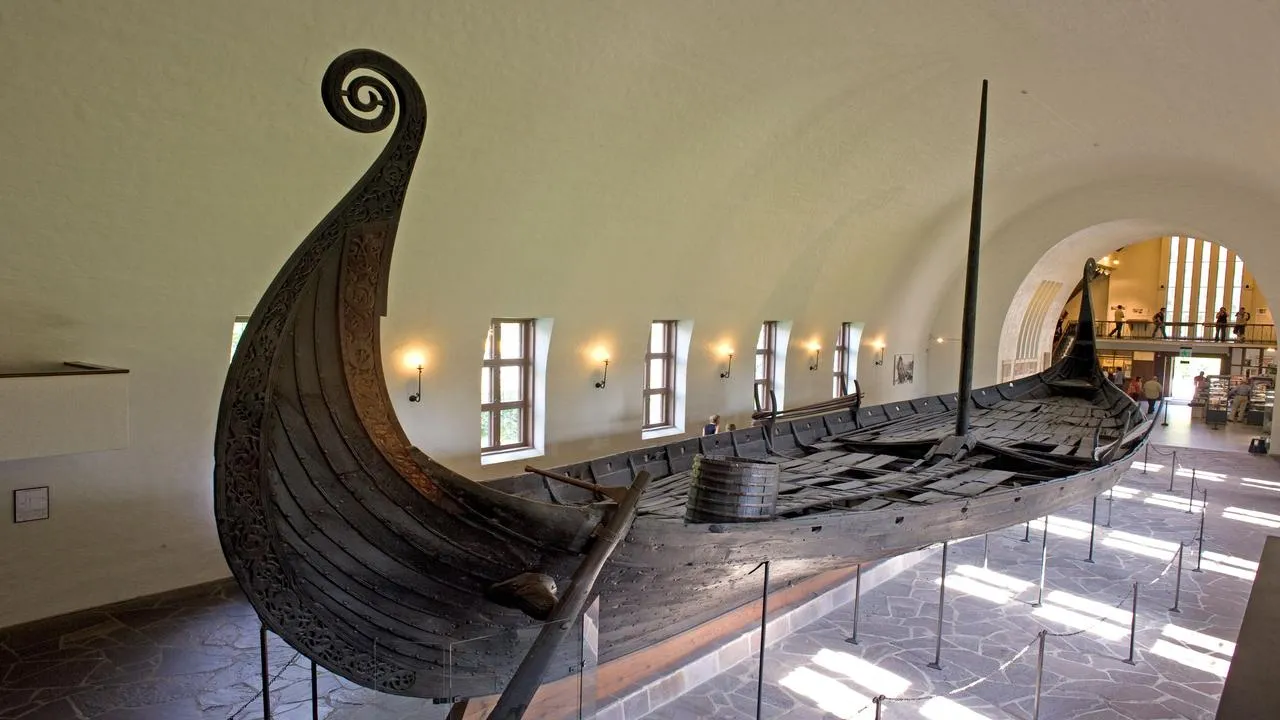
Why you should visit Oslo in October
Oslo weather in october, oslo events in october.
- Oslo's top places to visit in October
Flights, tours, and hotels in Oslo
Video guide.
October is a fantastic time to visit Oslo , as the city is adorned with the stunning colors of autumn. The weather is crisp and cool, perfect for exploring the city’s outdoor attractions. Additionally, October sees fewer tourists than the summer months, allowing for a more relaxed and authentic experience of the city.
In October, Oslo experiences the transition from the mild autumn weather to the onset of winter. The average temperature ranges between 3°C (37°F) and 9°C (48°F), with occasional rainfall. It’s important to pack warm clothing and an umbrella to be prepared for the changing weather conditions.
Nobel Peace Prize Forum
The Nobel Peace Prize Forum is a significant event in Oslo , focusing on promoting discussion and creating awareness about peace-related issues. It features panel discussions, presentations, and cultural events, attracting global participation.
Oslo International Film Festival
The Oslo International Film Festival showcases a diverse selection of international films, including documentaries, short films, and feature-length movies. It’s a fantastic opportunity to immerse yourself in the world of cinema and engage with filmmakers and film enthusiasts from around the globe.
Oslo Open House
Oslo Open House offers a unique chance to explore the city’s architectural treasures. Various buildings and spaces not usually accessible to the public open their doors for guided tours, providing insight into Oslo ‘s rich architectural history and contemporary design.
Oslo’s top places to visit in October
Vigeland sculpture park.
Vigeland Sculpture Park is a must-visit in October, as the autumn foliage enhances the beauty of the sculptures and the surrounding landscape. It’s a peaceful and contemplative space where visitors can admire the remarkable artistry of Gustav Vigeland.
Exploring Oslo Fjord in October offers breathtaking views of the autumn colors blending with the shimmering waters. There are various boat tours available, allowing visitors to soak in the natural beauty while enjoying the brisk, refreshing air.
Nordmarka Forest
Nordmarka Forest is a serene escape from the city, especially in October when the foliage is ablaze with vibrant hues. It’s an ideal destination for hiking, biking, or simply enjoying a tranquil picnic surrounded by nature’s stunning seasonal display.
Norwegian Museum of Cultural History (Norsk Folkemuseum)
The Norwegian Museum of Cultural History is an immersive experience in any season, but in October, the open-air museum takes on a special charm with the autumnal transformation of its historic buildings and landscapes.
For the best experience, consider purchasing the Oslo Pass, which provides free entry to many attractions and public transport within the city.
Tours in Oslo
On our website you can compare prices at 120 of the most popular travel agencies
Hotels in Oslo
On our website you can find and book hotels with a discount of up to 60% off
Flights in Oslo
On our website you can compare prices on 728 airlines to find the most suitable tickets
More articles on this topic
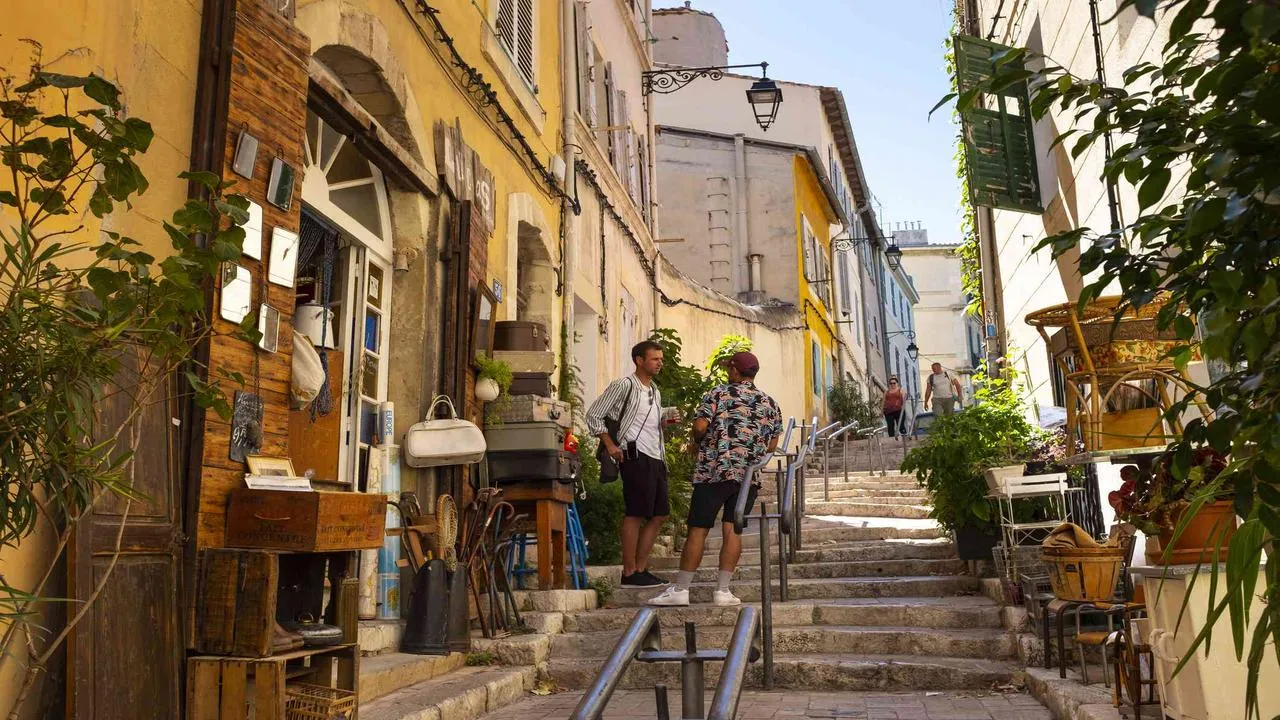
What to do in Marseille in October 2024
Why you should visit Marseille in October October is a fantastic time to visit Marseille, as the summer crowds have dispersed, and the weather is still pleasant. The city's vibrant...

What to do in Lucerne in May 2024

What to do in Bologna in July 2024
Why you should visit Bologna in July July is a fantastic time to explore Bologna, as the city comes alive with vibrant events, pleasant weather, and an energetic atmosphere. The...
- Search Please fill out this field.
- Manage Your Subscription
- Give a Gift Subscription
- Newsletters
- Sweepstakes
- Where to Go in 2024 Overview: Where to Go in 2024
- The 50 Best Places to Travel in 2024
- An Insider's Guide to Paris — Luxury Hotels, Vintage Shops, and the City's Best Restaurants Included
- This Southern U.S. City Was Named One of the Best Places to Travel in 2024
- 5 Coastal Towns in Alaska That Are Adorable in Any Weather
- T+L's Review of Regent Seven Seas Cruises’ Seven Seas Grandeur
- This Exclusive Helicopter Dining Experience Is the Best Way to See the 'Grand Canyon of Mallorca’
- Belmond Brought Back Its Most Thrilling Trains Through Asia – Here's What to Expect
- How to Plan the Perfect Trip to Montreal
- Georgia May Be Getting Its First National Park Soon — and It Has More Than Just Scenic Trails
- How to Plan the Perfect Trip to Costa Rica
- How to Plan a Trip to Italy's Amalfi Coast
- This Stunning Region in Portugal Is a Wine Lover's Dream
How to Visit Oslo, According to Someone Who Spent 6 Years in Scandinavia
- This South American City Is One of the Best Places to Travel in 2024 — Here's How to Visit
- The Caribbean's 'Nature Island' Has Rain Forests, Luxury Hotels, and a Rich Creole Culture
- This Midwestern Gem Is Home to Barbecue, Music, and a Flourishing Womens’ Sports Scene
- Where to Go in 2024 The 50 Best Places to Travel in 2024 An Insider's Guide to Paris — Luxury Hotels, Vintage Shops, and the City's Best Restaurants Included This Southern U.S. City Was Named One of the Best Places to Travel in 2024 5 Coastal Towns in Alaska That Are Adorable in Any Weather T+L's Review of Regent Seven Seas Cruises’ Seven Seas Grandeur This Exclusive Helicopter Dining Experience Is the Best Way to See the 'Grand Canyon of Mallorca’ Belmond Brought Back Its Most Thrilling Trains Through Asia – Here's What to Expect How to Plan the Perfect Trip to Montreal Georgia May Be Getting Its First National Park Soon — and It Has More Than Just Scenic Trails How to Plan the Perfect Trip to Costa Rica How to Plan a Trip to Italy's Amalfi Coast This Stunning Region in Portugal Is a Wine Lover's Dream How to Visit Oslo, According to Someone Who Spent 6 Years in Scandinavia This South American City Is One of the Best Places to Travel in 2024 — Here's How to Visit The Caribbean's 'Nature Island' Has Rain Forests, Luxury Hotels, and a Rich Creole Culture This Midwestern Gem Is Home to Barbecue, Music, and a Flourishing Womens’ Sports Scene CLOSE Part of Where to Go in 2024
Oslo, Norway, is a year-round destination — with saunas, fjord cruises, and fascinating museums.
Best Hotels and Resorts
Best things to do, best restaurants, best time to visit, how to get there, best neighborhoods.
The mere idea of a summer day in a place like Oslo — home to subzero waters and black-metal music — might seem like a mirage. But the summers here are famously light and hot, with the Norwegian capital being an ideal playground for sunbathing, swimming, fishing, and hiking, replacing the darker months’ skiing, ice bathing, and roaring fireplaces.
Beyond its outdoor pursuits, Oslo 's eco-conscious efforts exceed most cities. In 2016, it introduced a “climate budget” with a goal of reducing emissions by 95 percent by 2030; two years later, 1,000 trees were planted for the Future Library project ; and in 2019, the city was crowned the European Green Capital .
Oslo’s young professionals and creatives may scatter themselves among the hip, diverse neighborhoods of Grünerløkka and Tøyen, or the more upscale Frogner and St. Hanshaugen (picture Parisian-like facades and tree-lined streets with mansions), but the main thing this city’s dwellers have in common is their commitment to time spent in nature. Visitors will find eco-friendly hotels committed to eliminating waste and championing reusable materials, restaurants that support third-world communities, and spas and saunas dispersed between the city’s central harbor and the dense surrounding forest.
Christopher Larson/Travel + Leisure
At a time when travelers are becoming aware of how their leisure choices impact the environment, it’s interesting to see Oslo’s dedication to learning about and introducing the bigger ideas behind eco work. September’s Oslo Innovation Week, for example, is largely digital, with the aim of solving real global challenges through entrepreneurship, innovation, and green tech — the subjects of its panels include energy, circular economy, and life-science investment. For anyone interested in such, its panels and events make it a good time to visit.
For me, having spent six years in Scandinavia, and long summers and winters in Norway , Oslo became a base for months at a time. Most favor Danish and Swedish coastal cities for their accessibility. Like any capital, the Norwegian city is fast-changing and home to global diasporas that help shape the identity of this fjord-laden delight.
Top 5 Can’t Miss
- Any trip to Oslo calls for a bracing ice dip and sauna session.
- History buffs might note the elaborate original fixtures of Sommerro, a former electricity factory
- Restaurant Alex is the newest place to see and be seen, yet it's ultra-welcoming.
- Marvel at Vigeland, a park displaying nude sculptures.
- Go cross-country skiing or hiking, or simply enjoy the view from the top, at Nordmarka.
Francisco Nogueira
Not long after Sommerro's fall 2022 opening, the hotel and spa made its way on Travel + Leisure' s list of the 100 best new hotels in the world . Its electricity factory history is felt while the mid-century interior design and moody lighting offer a polished feel. The 231 rooms of various sizes include annexes, sloped ceilings, and exquisite upholstery, plus top-tier amenities and service. Don't miss the newly opened Izakaya, which serves a Nordic-Japanese menu.
Villa Inkognito
The next-door sibling property of Sommerro, Villa Inkognito is housed in a former private residence dating back to 1870. It was transformed into offices for the city’s first electrical company, and later served as the Algerian embassy. The 11-room retreat is also available on a full buyout basis for an ultra-special trip, and each room is meant to feel like a home away from home.
Amerikalinjen
This revved-up former Norwegian America Line headquarters toots its own stylish horn. The cheery staff resurrects the bustling energy of the storied spot , which is decked out in snappy tailoring from Norwegian fashion favorite Holzweiler. Guests can also expect a chic library, original elevators, and ceiling stuccos that remain across the rooms.
The Well Spa & Hotel
The Well Spa & Hotel provides a holistic approach to health — meaning uniform bathing suits and gowns, a zero-digital policy in restaurants and communal areas, excellent menus, relaxing treatments, and a decidedly tranquil feel in the stunning sculpture garden. Located in Sofiemyr, about 20 minutes from Oslo's city center via its own shuttle, the impressively vast property makes for a divine solo sojourn or a social spa trip.
Clarion Hotel The Hub
Located close to Oslo Central Station, Clarion Hotel The Hub stands out with its magnificent lobby showcasing marble features, a sumptuous bar, and refurbished rooms.
Taylor McIntyre/Travel + Leisure
With rugged natural terrain skirting the entire city, it’s no wonder most extra-curricular activities here revolve around getting outdoors. A winding, 20-minute tram ride up Nordmarka takes visitors to the place where the trees for Future Library are planted. Take the lift to ski jump Holmenkollen, then stop by Holmenkollen Restaurant for tartare, a hot toddy, and mountaintop views.
Sauna and Swim
In the winter, the adrenaline rush is rewarding, and come summer, the waters are refreshing. At Badstuforening , it's $25 for a two-hour communal seat; enjoy the peaceful camaraderie (and views) of this sweet setup. Just make sure to bring a towel. Alternatively, try Salt , a sauna and art space that's set opposite the Snøhetta-designed opera house and hosts concerts, plays, and exhibitions.
Museum Hopping
Explore the intricate history of explorer life at the Fram , which contains the reconstructed remnants of the ship that raced to the South Pole, headed by Norwegian adventurer Roald Amundsen. In the center of town, check out the Nobel Peace Center for its permanent and roving collections of significant human rights accomplishments. An unsung gem is the Emanuel Vigeland Museum , complete with frescoes and gong bath concerts. Tip: Plan in advance planning due to the location's unusual opening hours.
Silent Fjord Cruise
Take a silent electric fjord tour on the Brim Explorer , with multiple options to suit your mood. There’s yoga on the deck, an elegant brunch, or a dinner cruise. Other perks of this slick and small liner include less crowds and an intimate setting for your crew.
Courtesy of Restaurant Alex
Restaurant Alex
An overnight success with everyone from students to billionaires, this restaurant calls for advance reservations. Emerging chef Alexandra Ek guides a well-priced brasserie-style menu, while the resident DJs don’t frown upon dancing on tables after hours.
Sabi Omakase
Japanese cuisine this far from East Asia has a terrific head start thanks to the abundance of cold sea. At Sabi Omakase , guests can expect a carefully composed seasonal menu that's served in a harmonious, low-lit space. Interestingly, the chef used to be a surgeon — the locale and its offerings are not remiss of precision, and, yes, you’re safe in his hands.
Solsiden Restaurant
Solsiden is a fail-safe institution for seafood on the water, dapper and light-filled with its glass structure. Put on a pretty dress or shirt and enjoy the harbor breeze at this summer-only restaurant. Order the renowned shellfish tower and the Champagne.
It’s no secret Norway can whip the wallet. This fresh and lovely Asian noodle joint is a way of preserving splurges for another day while still giving you the opportunity to eat well. Plus, every purchase feeds a child in Africa, where founder André Evju spent lots of time.
Plant-filled with kitschy white tiles and pink lighting, Njokobok offers Senegal-style community dining. Order the jollof rice, grilled dorada, or whole lamb and indulge in the location's famous onion sauce three ways. Oslo has a sizable African diaspora, so you'll find good Ethiopian, Eritrean, Moroccan, and Somali restaurants throughout the city.
While winter is for snow and snuggles, summer in Oslo is all about swimming and seafood.
Spring (or shoulder season), meanwhile, is ideal for soaking up art, history, opera, and the boutique shops. June through September sees music festivals such as By:Larm and Øya , and winter is prime time for ski tournaments, cozying up in a cabin, and cold-weather rituals like ice bathing and relaxing in a sauna.
The main thing to consider is winter's darkness — there are nearly 20 hours under cover, compared to summer’s two-hour nights.
Flying into Gardermoen is ideal for easy access into the city — it's about 20 minutes via speed train. Arriving at another airport means a long bus ride to the city, so don't be duped by the cheaper inter-European flights to Torp Sandefjord Airport. Another way to arrive is by cruise — check out eco operators such as Hurtigruten. You might also consider the spectacular, nearly eight-hour, cross-country Bergen Line route — often dubbed one of the most beautiful train rides in the world. If you're arriving from elsewhere in the country, domestic airline Widerøe is a great option.
Andrea Pistolesi/Getty Images
This east-of-central pocket is having a resurgence, thanks to the introduction of some trendy bars and restaurants, but its leafy, suburban feel is enduring. In addition to its waterside location, there are gorgeous local bistros, Frogner Church, grand foreign embassies, and lots of indie cinemas here. Plus, you're still a stone's throw from the theaters, palace, Litteraturhuset (House of Literature), and Vigelandsparken (Vigeland sculpture park).
The peninsula of Bygdøy has not only amassed some of the capital’s best museums and relics, but it’s also home to idyllic beaches — Huk, Paradisbukta, and Bygdøy Sjøbad — for swimming and picnicking. For something a bit more cultural, browse the collections at the Fram, Norwegian Maritime Museum, Oscarshall, or Norwegian Museum of Cultural History. The Gol Stave church is also a must-see.
Day Trip to Drøbak
The wider area of Oslofjord is full of small towns, and picturesque-as-they-come Drøbak is a wonderful jaunt for the day. Just a 40-minute drive (or 90-minute scenic ferry ride) outside of Oslo, Drøbak is home to the dramatic Oscarsborg Fortress , great shellfish in cute old buildings, a summertime opera, and even a quirky year-round Christmas shop.
How to Get Around
Once you arrive in Oslo via the Flytoget airport transfer, walking is doable and preferable to most. An Oslo Pass is handy for riding the tram, train, bus, and ferry. E-scooters can be less arduous than biking if you need to dash somewhere, but locals prefer a more relaxed and measured approach to getting around.
Where to Go in 2024
Related articles.
The 8 best things to do in Oslo: art, culture and outrageously beautiful fjords

Jul 27, 2022 • 7 min read
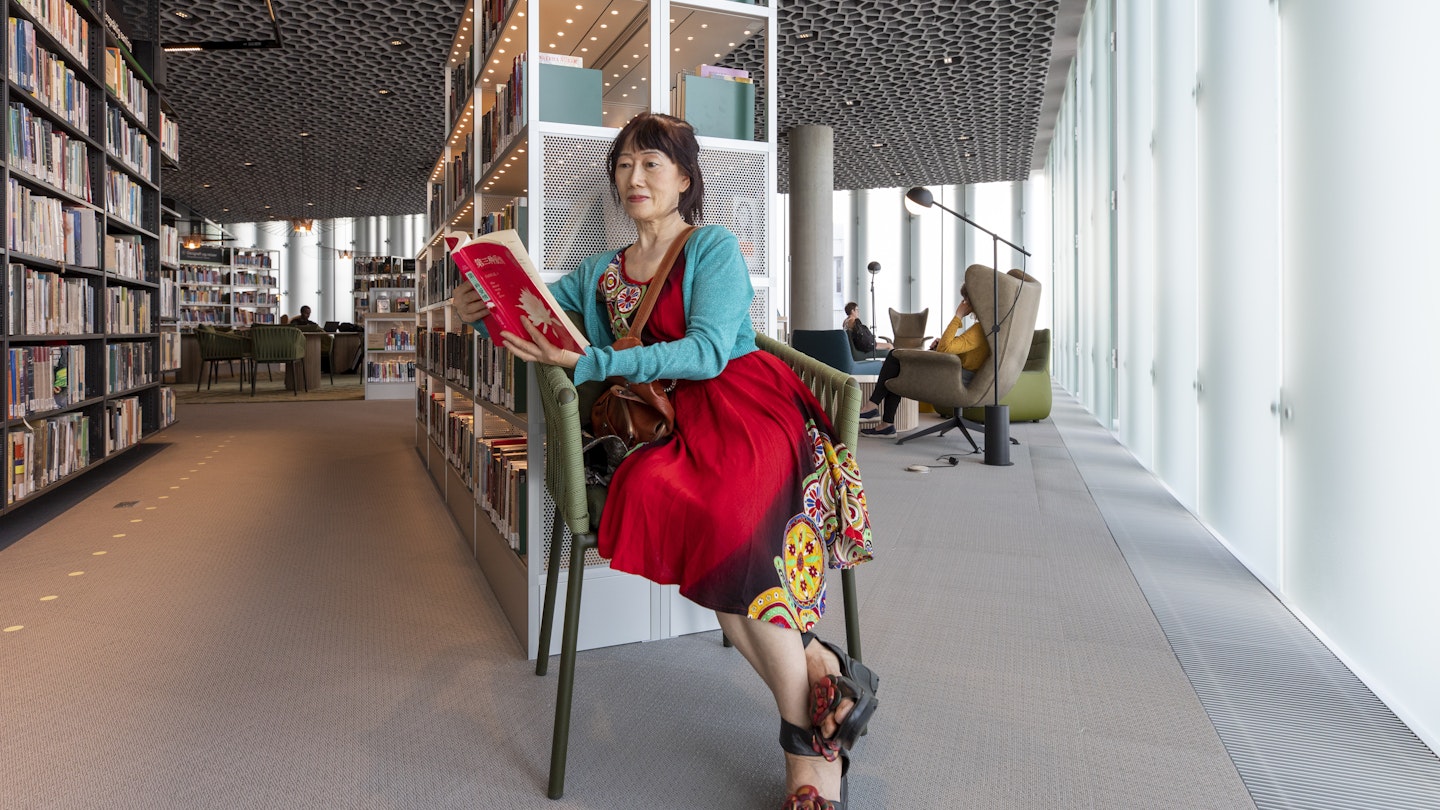
Don't miss the Deichman when visiting Oslo – it's not your usual library
Whether you’re making the most of the midnight sun or deep in the dark depths of the northern winter, you’ll find plenty to do in Oslo , Norway ’s capital city.
New openings in recent years – the Deichman Library, Munch and the National Museum – reflect the city’s commitment to preserving cultural heritage for centuries to come. And there’s plenty of artistic and literary creativity to celebrate here: Not only did local landscapes inspire artworks by painter Edvard Munch , Oslo was also home to Norwegian playwright Henrik Ibsen for the last 15 years of his life. If you’re planning to make the most of the city’s many museums, it’s worth buying the Oslo Pass that gives free admission to 30 different sights as well as use of the public transportation system.
The Viking Ship Museum (Vikingskipshuset) remains closed until 2026 while construction of a new state-of-the-art building is ongoing, but there are many other amazing things you can do in Oslo right now. Here are the very best.

Visit the city’s newest attraction, the world-class National Museum
With the largest collection of art and design in Norway, the brand-new National Museum is now the biggest museum in the Nordics. Don’t rush your visit – there are 6500 objects on display across 86 rooms. Follow the chronological route to explore the best art, design, architecture, crafts, and fashions from antiquity to the present day, seeing how they have shaped or reflected society.
There’s a small collection of Munch’s paintings, including The Scream , and you’ll also spot familiar names such as Vincent van Gogh and Georgia O’Keeffe. Learn about Norway’s folk tales and legends in the Fairy Tale Room and be sure to visit the third-floor Light Hall, an unusual gallery space with walls made of a glass-and-marble composite, currently exhibiting works by contemporary Norwegian artists.

Experience a fjord-side sauna
Finnish sauna culture has been adopted by Oslo over the last 10 years or so and has become a popular thing to do on the harborside. Dress in swimwear and take a seat on a bench in a paneled room that’s heated to 80–95°C (176-200°F) by a wood-burning stove. A towel is recommended to stop an uncomfortable burn on your butt.
From private saunas to huge group events with comedy, DJs and theater entertainment, cultural hub SALT has a sauna that holds up to 80 people. With a maximum capacity of 10, KOK ’s floating saunas are found at Aker Brygge and Bjørvika. If a slow-cook near the harbor isn’t private enough for you, book yourself on a KOK cruise. The whole unit is a boat that can dock at a more secluded part of the fjord. Be sure to jump in, either from the roof or straight from the deck – it’s cold but exhilarating.
Celebrate Norway’s favorite sculptor, Gustav Vigeland
Vigelandsparken is a free-to-visit sculpture park dominating Frognerparken to the western suburbs of Oslo. More than 200 incredible granite, iron and bronze works here form the life’s work of prolific Norwegian sculptor Gustav Vigeland. He was inspired by the complex nature of humankind, which is reflected in the twisted positions and facial expressions of many of his figures.
Here you’ll see everything from a classic Greek-style fountain made up of muscular men weighed down by a dish, to family-like groups including mid-tantrum children with sulky expressions, and the distinctive bronze Little Hot-head , a child in a rage. The remarkable centerpiece is the 17m-tall (56ft) Monolith , a single piece of granite carved to form a huddle of 121 separate human figures. Nearby, the Vigeland Museum , housed in a Neoclassical building, offers a more in-depth look at the artist’s work.

Learn and create at Deichman Library
When you visit Deichman , throw away any thoughts of a traditional library. This six-floor airy art-filled space – voted Public Library of the Year in 2021 – aims to be not only a lender of books, but a warm and welcoming environment for people who want to learn, create, explore, work, and socialize.
Want to learn how to make clothes? There’s a whole section of sewing machines for you to reserve. Interested in how 3D-printing works? You can give it a go. There are music rooms where you can borrow and practice instruments, games to play, a stage overlooking the fjord, and even cinemas, all free for public use. For those preferring a more conventional library experience, don’t worry: The shelves hold 450,000 books with plenty of quiet seating areas dotted around the building.
Get out on the fjord by catamaran, boat, kayak or SUP
You can happily gaze at Oslo Fjord from the harborside, but it’s so much better to get out on the sparkling water for a closer look. Make a day of it on the impressive all-electric catamaran Legacy of the Fjords , which glides almost silently across the water on its two trips per day (1h 45mins) to the island of Oscarsborg (also served by commuter ferries B21 and B22), where you can explore the historic Oscarsborg Fortress .
For a shorter and cheaper fjord trip, head out on the commuter routes that are included in the Oslo Pass. Route B2 departs from Aker Brygge to nearby Hovedøya, Gressholmen and Langøyene, and B10 heads for Nesoddtangen, which takes around 20 minutes. If you’re looking for something a little more active, Mad Goats rents out kayaks, stand-up paddleboards, and offers guided kayak tours of the fjord.

Delve deep into the works for Edvard Munch
Munch opened on the waterfront in Bjørvika in October 2021 as a new home for the collection that the artist Edvard Munch bequeathed to the city four years before his death in 1944. Across 11 galleries, you can see The Scream (yes, there’s a version here too), as well as paintings, prints and sketches exploring themes of sickness, melancholy, and nature. Changing exhibits with new interpretations of Munch’s art keep the displays fresh and engaging.
Enjoy wonderful fjord views from the higher levels of this glass-and-steel building, with fine dining in 12th-floor Bistro Tolvte and an elegant 13th-floor cocktail bar. Don’t miss The Mother by Tracey Emin. The curves of the new bronze sculpture contrast with all those harborside angles, sitting fjord-facing on the pier outside the museum.
Walk up the angled roof of the opera house
One of Oslo’s waterfront architectural masterpieces is the opera house , home to the Norwegian National Opera and Ballet . The glass-and-marble structure was designed by award-winning architects Snøhetta to resemble a glacier, with the aim of not only creating state-of-the-art rehearsal rooms and performance halls ( tours are available), but also to provide a new space for public use. The angled roof is accessed directly from ground level – through walking a series of steps or steep sloped sections you reach the rooftop where there are panoramic views over the harbor and the city.
Hear the good news outside the Nobel Peace Center
The Nobel Peace Center changes its display every November to honor the latest winner or winners of the Peace Prize. In 2021-22 the prize went to Russian editor Dmitiri Muratov and Philippine journalist Marisa Ressa who have relentlessly worked for freedom of the press, questioning, challenging and pushing their governments for answers, often in dangerous circumstances.
A hands-on exhibit explores the legacy of the Peace Prize, giving visitors the chance to see what kind of peacemaker they might be. If you’re nearby at midday on a Friday (April to October) listen out for the “good news” announcement, where something positive that has happened in the world is recognized. A dove is symbolically released from a window of the museum to send the good news out into the world.
Claire traveled to Oslo by invitation from Visit Oslo .
Explore related stories
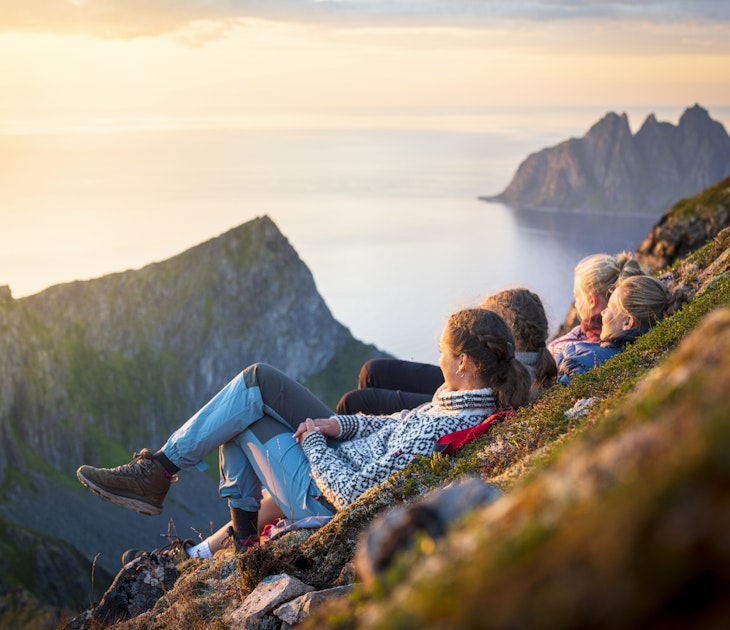
Mar 12, 2024 • 7 min read
From cruising the fjords and wild camping to cities full of culture and incredible food, here are 13 top things to do on a visit to Norway.
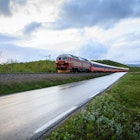
Feb 21, 2017 • 6 min read
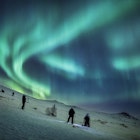
Oct 20, 2014 • 5 min read

Aug 8, 2013 • 6 min read

Mar 21, 2024 • 6 min read
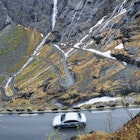
Mar 19, 2024 • 9 min read
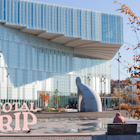
Oct 24, 2023 • 9 min read
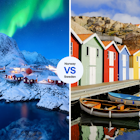
Jul 28, 2023 • 6 min read
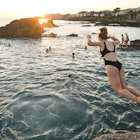
May 22, 2023 • 5 min read
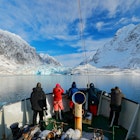
Sep 15, 2022 • 10 min read

Best Time to Visit Oslo (Weather, Tourist Seasons & More)
Travel author
I love traveling and writing about my exploits as a travel blogger and freelance writer. You’ll find me curled up in my reading corner, enjoying a cup of tea and a romance novel when not busy.
As an Amazon Associate, I earn from qualifying purchases
As Norway’s capital and largest city, Oslo offers many tourist opportunities.
Visitors can expect modern architecture, cool museums, beautiful landscapes, amazing seafood, and more.
The city also has great weather for hiking, biking, fishing, swimming, skiing, and other outdoor activities.
That said, Oslo experiences different seasons that make it possible to engage in some activities more than others. So, when are the best months to visit Oslo?
Well, it depends on the weather and the activities you enjoy most. But keep reading to learn more about this city.
Table of Contents
Tourist Seasons in Oslo
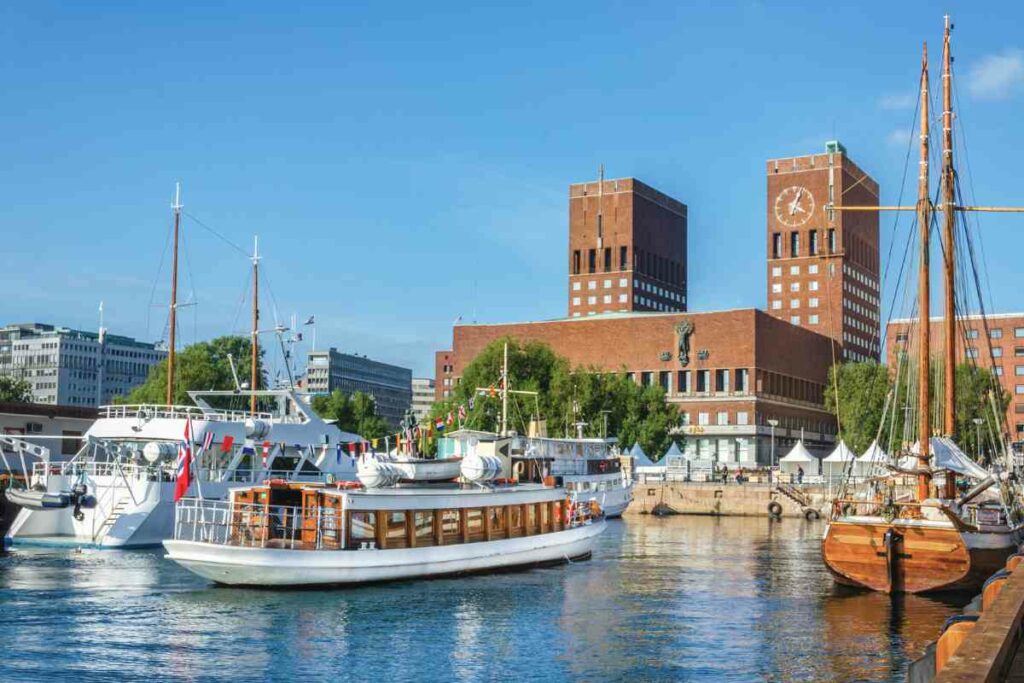
- Peak season: July and August
- High season: May, June, and September
- Low season: October and December
- Very low season: January, February, March, April, and November.
Oslo Seasons and What to Do In Every Season
The city of Oslo experiences all four seasons: spring, summer, fall, and winter. Each season offers conditions suitable for doing certain activities more than others.
So, while there’s no wrong time to vacation here, some seasons may be more suitable for the activities you want to engage in.
We’ve put together the ultimate seasonal guide to help you decide the best and worse time to plan for your visit.
Summer (Mid-June – Mid-August)
Summertime in Oslo is warm, with July being the warmest month at about 21.5°C.
The days are long as the sun rises between 3 am and 4 am and sets as close to 11 pm.
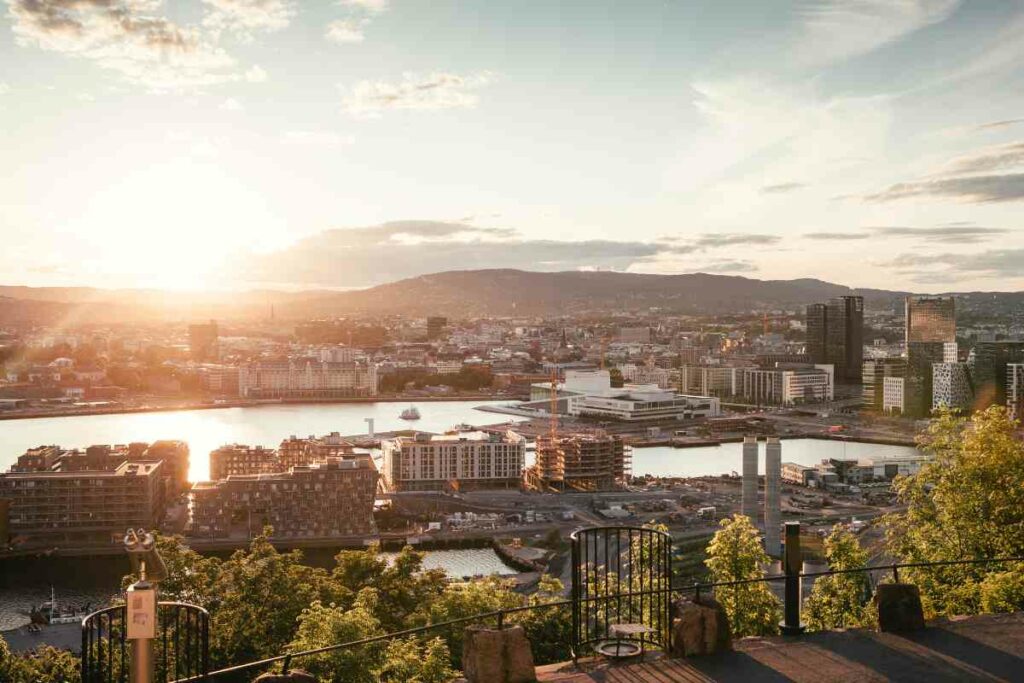
Summer is perfect for sightseeing thanks to the favorable weather, long daylight days, and good road conditions.
Be sure to stop by the following tourist spots:
- Oslo Opera House
- The Vigeland Sculpture Park
- Frogner Park
- Oslo City Hall
- Museums in Akershus Fortress
- Folk Museum of Norway
- The Royal Palace
- Explore Oslofjord by Boat
- Oslo Cathedral
- Aker Brygge
- Natural History Museum & Botanical Gardens
- TusenFryd Amusement Park, etc
Summer is also the perfect time to engage in outdoor activities.
You can visit Oslofjord, perfect for swimming, fishing, kayaking, boat rides, and more. You can take in the entire city’s beauty as you cool off.
Do you enjoy intense and thrilling activities? You can zipline down the world-famous Holmenkollen Ski Jump while getting the best views of Oslo.
The city hosts several festivals during summertime.
For instance, the Norwegian Wood is one of the best music festivals in Oslo, and it takes place in June each year. You can also visit the Opera House for some great live music.

Fall (August – October)
The average temperature for the fall season is 12°C, but it starts to get colder towards October in preparation for the winter season.
The chill weather makes it ideal for hiking, especially if you want a quieter ambiance or seek an interesting viewpoint.
August-October is among the most beautiful months in Oslo, with crisp air and beautiful autumn colors of yellow, orange, and red.
Below a list of things to do in Oslo during the fall season:
- Hiking to Grefsenkollen, Vettakollen, or in Nordmarka
- Visit the Botanical Garden, especially in September when the flowers bloom. In October, you can see the leaves changing colors.
- Appreciate art and nature at Frogner Park.
- Sample Norwegian comfort food, including waffles, meatballs, and a hot dog in a potato tortilla. While you’re at it, try a shot of Aquavit.
Winter (December – March)
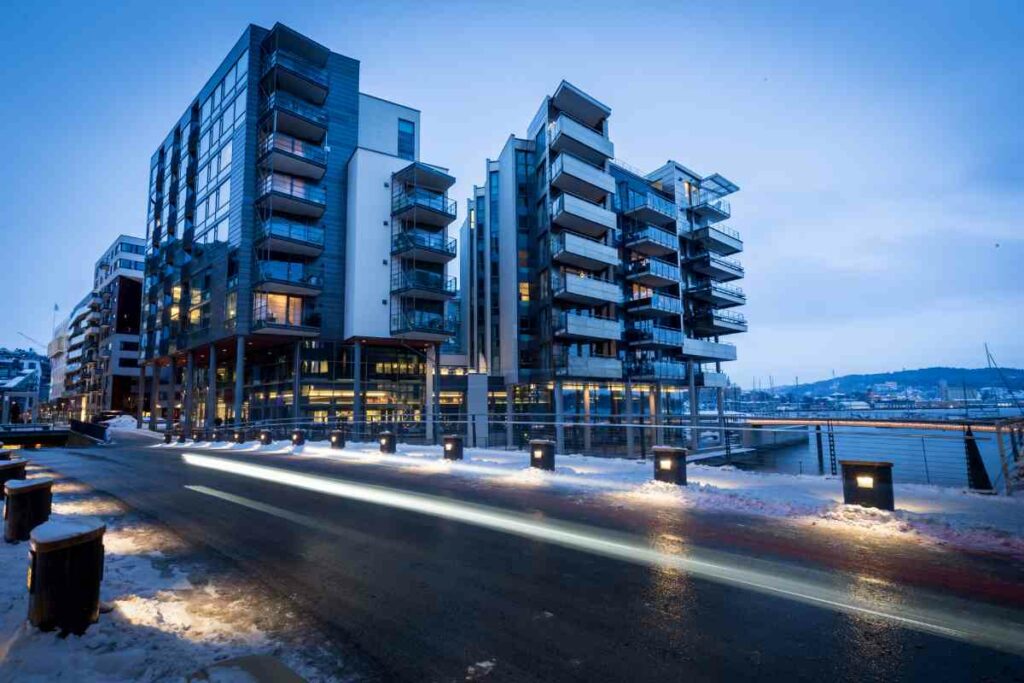
Winter in Oslo is quite cold, with long, dark, and wet days. Temperatures dip below freezing point, and snowfall is common, especially in March.
The weather is far too cold to be enjoyable for warm-weather travelers, but it’s suitable for engaging in winter sports.
Skiing, snowboarding, ice skating, and sledding are some fun activities to enjoy in winter.
Just because it’s cold outside doesn’t mean you should stay indoors. Oslo has and is surrounded by several parks and forests where you can enjoy nature.
Festival lovers should visit during the Christmas season. They’ll be treated to gingerbread galore, Christmas parties, and festive markets. They can also go sightseeing under fairy lights and enjoy festive food and drinks.
Oslo’s winter is magical and the best time to travel to witness a snowy wonderland.
Near the city is the Holmenkollen Ski Museum and Tower, which showcases thousands of years of skiing history. The observation deck at the top offers amazing views of Oslo.
Spring (April – Mid-June)
As the snow begins to melt, the city comes alive. The days are much longer and warmer, the air is clearer, and the weather is more stable.
This offers a great opportunity to explore the city on foot and engage in outdoor activities.
Vacationing in spring also offers a more relaxed atmosphere. And with the flowers blooming and trees turning green, it’s also the ideal time for nature lovers to travel to Oslo.
March and April also have many public holidays. And while most places close down, you’ll interact with the Norwegian people.
The 17 th of May is a national day with big celebrations nationwide. The streets of Oslo are often filled with parades and people in traditional dresses.
So, When Should You Visit Oslo?
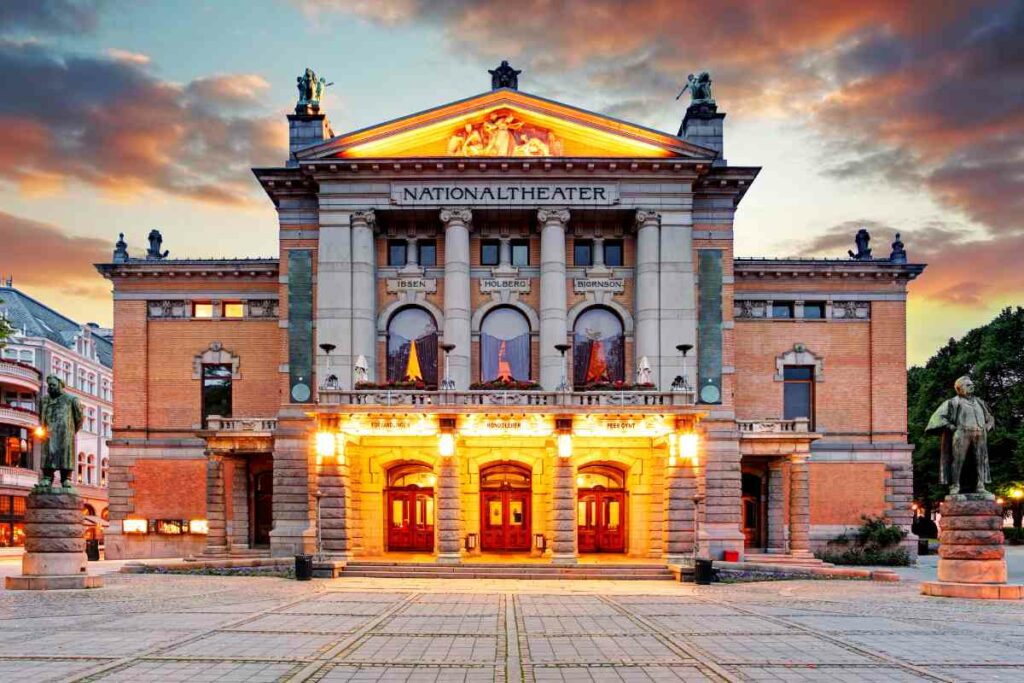
Summer seems to be the best time to visit Oslo as the warm and longer days allow visitors to explore everything the city offers.
On the downside, being the busiest time of the year for tourism also means things may be costly.
Booking your flights , accommodation , and tours in advance is important, so you don’t miss a spot.
Winter is dark, wet, and windy, making it an off-peak season. But this also means less crowding and a chance to save on traditionally expensive hotels.
While many tourist attractions are closed for winter, the snow is good for winter sports. Plus, the season brings Christmas parties, food, and a chance to celebrate with the locals.
Late May and early June are when everything comes to life in Oslo. The flowers bloom, the landscape turns lush green, and the atmosphere relaxes.
Oslo is an exceptionally beautiful tourist destination that visitors can enjoy year-round.
But if you love specific weather or are looking for a specific activity, this article provides the information you need to plan the perfect trip.
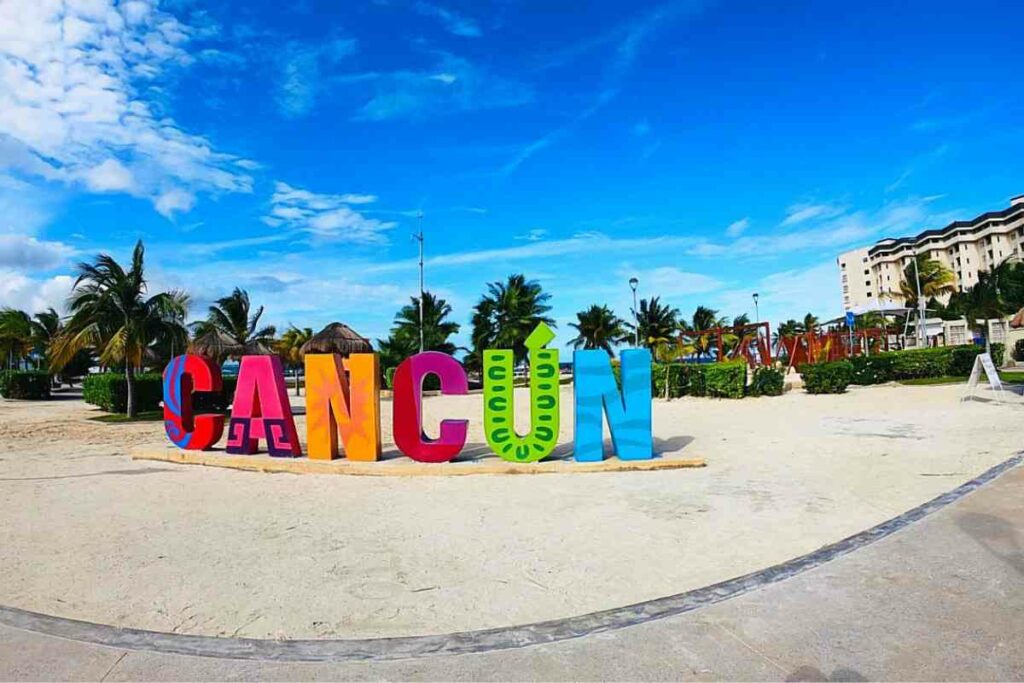
Affiliate Disclaimer
As an affiliate, we may earn a commission from qualifying purchases. We get commissions for purchases made through links on this website from Amazon and other third parties.
Latest posts

Ulanzi U60 RGB Video Light Review: Top Vloggers’ Choice?
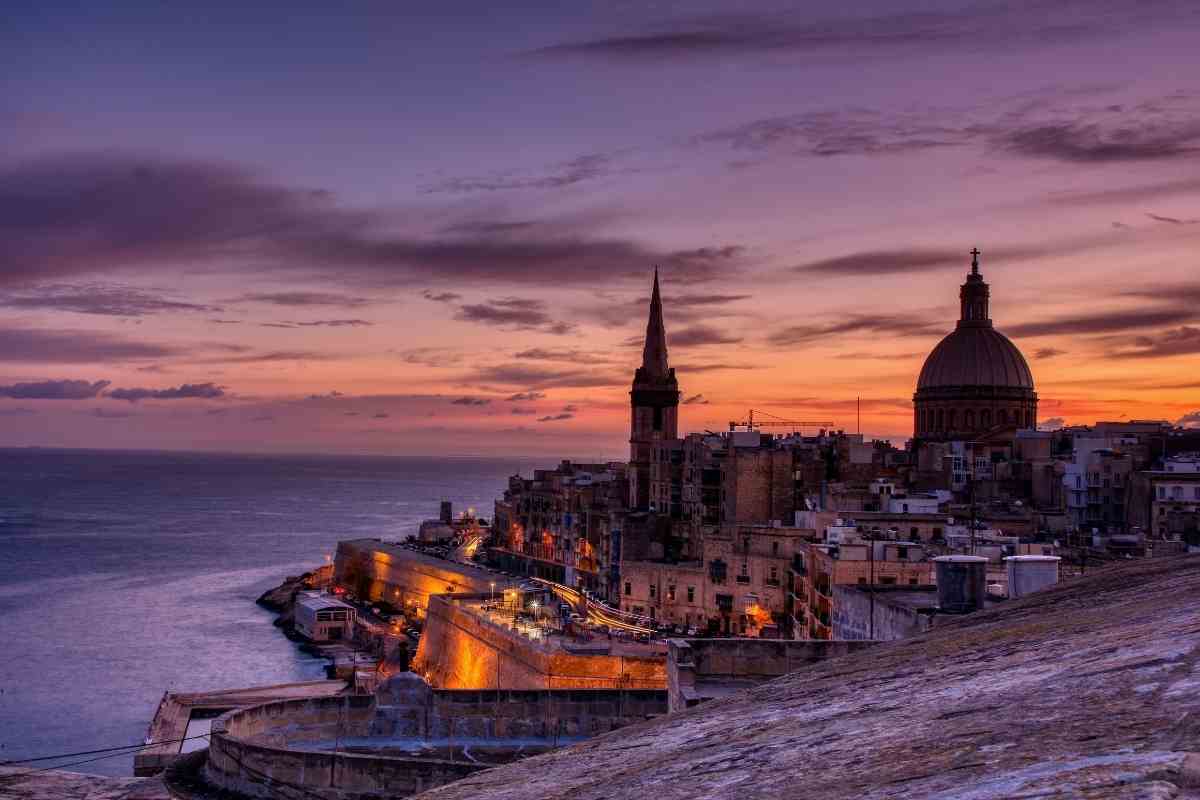
What Is Malta Famous For? Malta Local History and Past Events
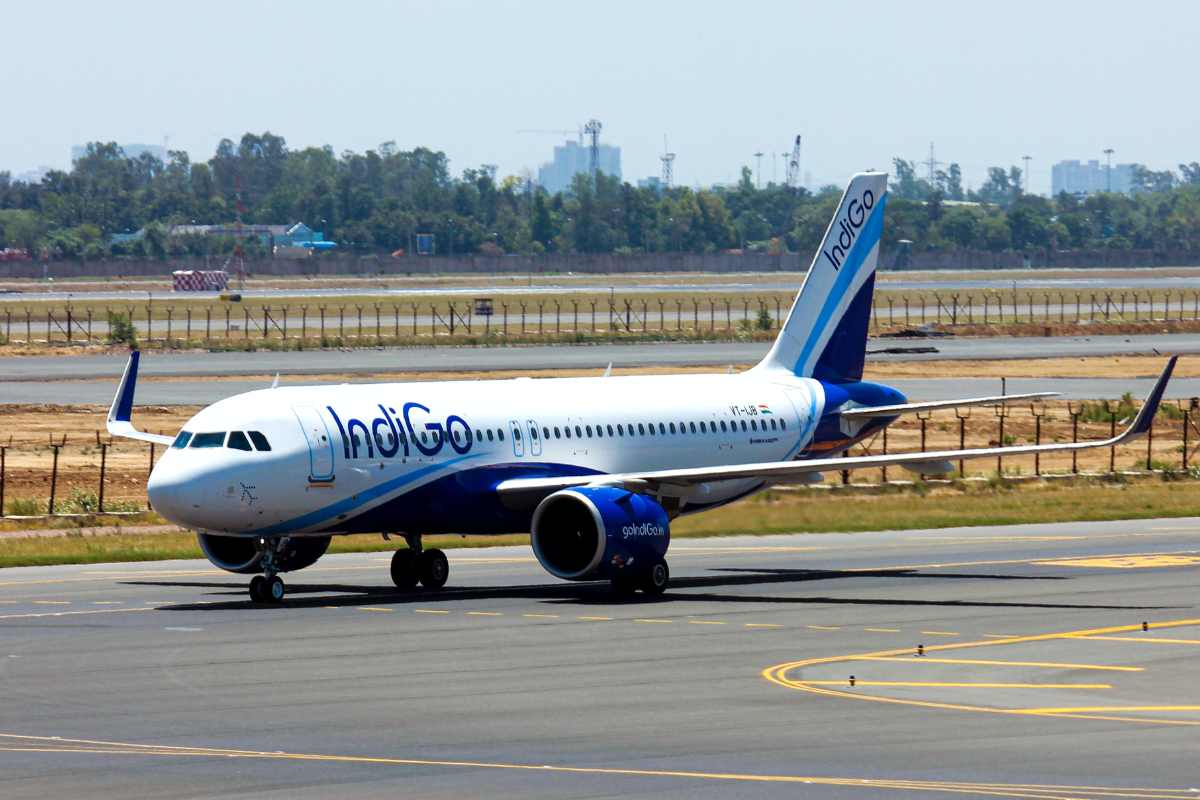
Do IndiGo Airlines Provide Headphones? In-Flight Entertainment Explained
Oslo Travel Guide

Courtesy of william87 | iStock

Why Go To Oslo
From the refurbished waterfront of Aker Brygge to the snowy hilltops of Holmenkollen, Oslo seems to offer the traveler everything they could ever want: hip cafes and nightlife, a verdant landscape (Oslo is one of the most forested cities in the world) and a culture steeped in arts and history. Where could this town go wrong?
It's expensive. The city consistently ranks among the world's most overpriced. So how do you get around the cost barrier? Consider making a weekend stopover from elsewhere in Europe (hotel rates are cheaper on Fridays) and enjoy Norway's capital while it's still a city on the rise.
Find Flight and Hotel Deals
Navigate forward to interact with the calendar and select a date. Press the question mark key to get the keyboard shortcuts for changing dates.
Navigate backward to interact with the calendar and select a date. Press the question mark key to get the keyboard shortcuts for changing dates.
- # 1 in Best Places to Visit in July 2024
Best of Oslo
Best hotels in oslo.
- # 2 in Hotel Continental Oslo
- # 3 in Amerikalinjen
- # 4 in THE THIEF

Best Things to Do in Oslo
- # 1 in Oslo Fjord
- # 2 in Vigeland Park (Vigelandsparken)
- # 3 in Karl Johans gate

Popular Tours

Oslo Combo Tour: Grand City Tour and Oslo Fjord Cruise
(340 reviews)
from $ 136.27

Guided Oslo Fjord Cruise by Silent Electric Catamaran
(277 reviews)
from $ 57.43

Oslo Highlights Bike Tour
(551 reviews)
from $ 46.56
Oslo Travel Tips
Best months to visit.
The best time to visit Oslo is from May to August when the temperatures rise and there are surprisingly affordable room rates available, though these options often fill up fast. Daytime temps generally hover in the 60s and 70s, but evenings can get chilly at times, so remember to bring a coat. Like Stockholm and Reykjavik , Oslo can experience nearly 24 hours of daylight in the summer, with the famous midnight sun usually appearing in June or July. On the flip side, there are winter days of near total darkness. This is matched with frigid weather and temperatures diving into the 20s.
Weather in Oslo
Data sourced from the National Climatic Data Center
What You Need to Know
Norwegians are courteous Manners are everything in this refined city. You should particularly remember to be on time no matter where you're going; punctuality is highly expected in Norwegian culture.
Aquavit is the local spirit of choice Unlike other varieties, Norwegian aquavit is made from potatoes and aged in sherry oak casks. You'll find it served at restaurants and bars year-round, but it's especially popular to drink with traditional fare during Christmas.
It's a city of neighborhoods Though you'll be tempted to stick to the city center, save time for visits to surrounding neighborhoods like Grünerløkka and Majorstuen if you want to enjoy some of Oslo's best shops, eateries and nightlife venues.
How to Save Money in Oslo
Don't plan a summer visit For more affordable airfare and room rates, arrive between October and April, Oslo's coldest months. If you're set on enjoying some warmer weather, try visiting in May or September, the beginning or end of the city's peak season.
Don't forget your Oslo Pass This timed card, which costs 210 to 745 kroner ($25 to $89) per person, covers travel on all public transit (excluding airport routes), admission to 30 attractions and discounts at multiple restaurants. You can buy your pass at select hotels and museums or online here . Preordered passes can be picked up at the Oslo Visitor Centre after presenting a valid voucher.
Don't take the taxi from the airport Taxis in Oslo are notoriously expensive, so hop on the Flytoget train instead. A one-way adult ticket costs 190 kroner (less than $23), while round-trip fares for adults cost 380 kroner (about $45.50) each.
Culture & Customs
Oslo's Viking roots, iconic structures, rich art scene and abundant music festivals make this Norwegian city a haven for history buffs, architecture enthusiasts, art aficionados and music lovers. To learn more about Oslo's history, head to the Viking Ship Museum, the Norwegian Museum of Cultural History and the Royal Palace . For a glimpse at some of the area's most iconic buildings, stop by the medieval Akershus Fortress or the contemporary Oslo Opera House (opera fans should also plan to take in a performance here). Other genres are celebrated at events like Granittrock and the Ultima Oslo Contemporary Music Festival, both of which take place every September. If art is your passion, check out the National Museum of Art, Architecture and Design , where one of two painted versions of Edvard Munch's "The Scream" is on display. The other (plus a pastel version) can be found at the Munch Museum.
The official language in Norway is Norwegian, but many Norwegians – especially those living in Oslo – also speak English. Still, locals appreciate when tourists attempt to speak Norwegian. Key words and phrases to use include "hallo" (hello), "tusen takk" (thank you), "Snakker du engelsk?" (Do you speak English?) and " ha det bra" (goodbye).
As is the case in other Scandinavian countries such as Denmark and Sweden, the euro is not the official currency in Norway like it is in the majority of European Union countries. Instead, Norwegians use the Norwegian krone. One Norwegian krone equals about $0.12, but you'll want to check the latest exchange rate before you visit. International currencies are rarely accepted in Norway, and some shops and markets don't take foreign credit cards as a form of payment, so plan accordingly.
Tipping is uncommon in most European cities, including Oslo. However, locals occasionally tip bartenders and restaurant waitstaff when they've received exceptional service. There is no expected rate, but generally, patrons who want to tip will leave five to 15 percent of their bill.
What to Eat
Although Norway's dining scene isn't as highly regarded as those found in other European countries like France and Italy, its abundance of fresh ingredients – including lamb, reindeer and other meats, plus seafood, such as cod and salmon – make for tasty dishes. Norway's breads and pastries are also worth trying. One of the country's most popular dishes is smørrebrød (buttered rye bread topped with either local cold cuts or fish). Other popular items include fårikål (a stew made with lamb and cabbage), r økt laks (smoked salmon) and kjøttkaker (beef meatballs served with cranberry sauce and mushy peas or creamed cabbage). Those with a sweet tooth should try lefse (a rolled flatbread covered in butter, sugar and cinnamon that's commonly enjoyed with coffee), and for adventurous foodies, Norway offers smalahove (sheep's head) and lutefisk (lye-cured cod).
Sentrum's bayside area of Aker Brygge is Oslo's go-to spot for excellent drinking and dining venues, which include an assortment of upscale restaurants and cafes serving local fare. However, everything from food trucks and markets to Michelin-starred restaurants are available throughout the city. To taste some of Oslo's best Norwegian dishes, locals and visitors alike recommend visiting Maaemo and Statholdergaarden , which have both earned Michelin stars.
For more affordable fare, consider sitting down for a meal at one of Oslo's ethnic restaurants. American, Japanese, Indian and Italian are just some of the cuisines available here. Traveler-approved ethnic eateries include San Francisco Bread Bowl , Campo de' Fiori and TUNCO .
No visit to Oslo would be complete without trying aquavit (or akevitt in Norwegian). Generally consumed during holidays, Norway's national drink is a potato-based liquor aged in sherry oak casks and flavored with herbs and spices like caraway and dill. Most restaurants and bars sell the beverage, which anyone age 18 or older can drink.
Oslo is considered one of the safest capital cities in Europe. Although some European countries are dealing with growing terrorist threats, Norway rarely suffers from terrorist attacks. However, as the country's status as a tourist destination has grown, so have the incidents of petty theft, especially in Oslo. Keep an eye out for pickpockets in areas around top attractions , hotel lobbies and transportation hubs. To learn more about how to stay safe while visiting Norway, check out the U.S. State Department's website .
Getting Around Oslo
The best way to get around Oslo is on the trams or buses, as they're widely available and conveniently connect passengers to points throughout the city. When you arrive at Oslo Airport (OSL), you can take a train, bus, taxi or rental car into the city center. The T-bane metro system is also available downtown, though its network is limited compared to the trams and buses. Meanwhile, walking and biking are viable (and affordable) options for shorter treks on warmer days.
Entry & Exit Requirements
To visit Norway, you'll need a passport that's valid for at least six months beyond your departure date. Proof of sufficient funds and a return airline ticket must also be presented upon arrival. A visa is not required for Americans who stay less than 90 days. For more information on entry and exit requirements, visit the U.S. State Department's website .
Everything from colorful homes to historical buildings to modern skyscrapers can be seen nestled within Oslo's lush landscape.
Explore More of Oslo

Things To Do
Best hotels.

You might also like

# 9 in Best Places to Visit in June 2024

# 9 in Best Family Vacations in Europe

# 16 in Best Christmas Vacations
If you make a purchase from our site, we may earn a commission. This does not affect the quality or independence of our editorial content.
Recommended
The 28 Best Water Parks in the U.S. for 2024
Holly Johnson|Timothy J. Forster May 8, 2024

The 18 Best Napa Valley Wineries to Visit in 2024
Lyn Mettler|Sharael Kolberg April 23, 2024

The 25 Best Beaches on the East Coast for 2024
Timothy J. Forster|Sharael Kolberg April 19, 2024

The 50 Best Hotels in the USA 2024
Christina Maggitas February 6, 2024

The 32 Most Famous Landmarks in the World
Gwen Pratesi|Timothy J. Forster February 1, 2024

9 Top All-Inclusive Resorts in Florida for 2024
Gwen Pratesi|Amanda Norcross January 5, 2024

24 Top All-Inclusive Resorts in the U.S. for 2024
Erin Evans January 4, 2024

26 Top Adults-Only All-Inclusive Resorts for 2024
Zach Watson December 28, 2023

Solo Vacations: The 36 Best Places to Travel Alone in 2024
Lyn Mettler|Erin Vasta December 22, 2023

26 Cheap Beach Vacations for Travelers on a Budget
Kyle McCarthy|Sharael Kolberg December 4, 2023


Best time to visit Oslo – things to do in every season
Table of content
Are you thinking of visiting Oslo for your next adventure? Good choice! But what is the best time to visit this charming city, and are there any fun things to do in this Viking capital that won’t cost you an arm and a leg? Well, plenty! Stay with me here and discover our traditions and traditional food, when the best time to visit is, what activities are worth paying for, and what you can do for free. Oslo is a very walkable city, so wear your sneakers and enjoy!
Happy reading!
Here are a few facts about Oslo: – Oslo is the capital of Norway and has a population of approximately 700 000 – Oslo city is situated at the end of the Oslofjord, and to the north and east, forested hills (Marka) rise above the city. – Oslo can be visited in winter and summer due to its perfect location for seasonal activities. – Oslo is the only place outside Sweden that hosts a Nobel Prize Reward – Nobel Peace Prize – Oslo was the ninth most expensive city in the world in 2018 (according to the report made by EIU) but was not on the list in 2019. According to Business Insider, it is not on the most expensive city list in 2020 either. Let’s hope it will stay this way. Norway is the eighth happiest country in the world (toppled by Finland), falling from fifth in 2020 to third place in 2019 – Oslo has been voted Europe’s Green Capital for 2019 by Lonely Planet – Oslo has made it to “The Cool List 2019,” curated by National Geographic, taking 11th place out of 19
Best time to visit Oslo and things to do in every season
The best time to visit Oslo and the rest of Norway is spring, summer, winter, and fall. Yes, you read it right. You can visit Oslo any time of the year; it has great weather and time.
There are many things to do in Oslo during spring and summer – enjoy Holmenkollen Skifestivalen (cross-country skiing, ski jumping, and combined world cups) in March, Norwegian Constitutional Day on the 17th of May, and music festivals during the summer months. These activities run yearly, except for celebrating our Constitutional Day, the 17th of May. You will have to pay for the rest of the events.

Things to do in Oslo in winter
Winter in Oslo is long, dark, and usually wet, although it is not nearly as cold as in the North of Norway. The Winter season can start in November and last until April. Oslo weather in winter can be tricky to predict, except that it is cold, and we WILL get snowfall.
The average temperature for Oslo in winter is about -5C, and a normal 60 mm of precipitation could be rain or snow. Although the average temperature is around -5C, check the forecast before coming to Oslo and bring the right clothes. We have had to -16C and wind, and it can feel like you will freeze all your limbs off. Norwegians love wool; you can get woolen clothes in any sporting goods store. January and February are perfect for snow activities; you don’t have to leave town to go skiing downhill, ice skating, or tobogganing. Whatever activities you will be doing, get an Oslo Pass for 24, 48, or 72 hours, which includes free public transportation, entries to several attractions and museums, and discounts at some restaurants and shops.
If you want to visit an extra cold and extraordinary place in Norway, I recommend you visit Svalbard. You can check Worlderingaround post on things to do on Svalbard to get an idea of what there is to do on this archipelago and specifically on Spitzbergen Island.
Click on the pin to save it to Pinterest

Oslo in January and February
Holmenkollen Ski Jumping Arena is known for biathlon and Nordic skiing venues and hosts annual World Cup tournaments. Holmenkollen arena includes the famous Holmenkollen Ski Jump, Midtstubakken Ski Jump, five smaller recruitment slopes, cross-country skiing trails, and a ski stadium. Take metro line 1 from any of the central metro stations (for example, Sentral Stasjon Oslo S or National Theatre) to get to the arena, and on your way, you will get the most amazing views of Oslo from above. It takes you about 30 minutes to get to Holmenkollen by metro. The arena includes a ski museum, jump tower, souvenir shop, ski simulator, and a café.
- Hong Kong itinerary – best things to do in 3 days
- Where to eat in Paris – 3 restaurants worth your money

Frognerseteren Cafe and Restaurant is worth a visit, too. Take the metro further up to the end station after you have visited Holmenkollen Ski Jump Arena. The metro tour will take about 10 minutes. This cafe has the most amazing views of Oslo and Oslo Fjord, and during winter, you can enjoy their famous apple tart and hot chocolate. Frognereseteren’s history started in 1891, and their culinary history dates back to the same time. During my younger years, I used to work there and can personally recommend it for the views, atmosphere, and apple tart. During the winter and sometimes during summer, if the weather is miserable, they lit many of the fireplaces they have inside.

Oslo Winter Park

Korketrekkeren is a 2000-meter toboggan run with an elevation drop of 255 meters. The ride takes 8-10 minutes. You can hire sleds at Akeforeningen, down the hill from the Frognerseteren metro stop. The activity is free, but you must pay to rent the sleds unless you bring your own. Once you are down, you can take the metro back up and go again. The run is open only when there is enough snow, so check snow conditions before getting up there for the tobogganing. Take metro line 1 from any central metro station (see above) and get off at the end station Frognereseteren.
If you are coming to Norway in the winter and want to explore beyond Olso, I recommend you take a bus to Beitostølen. It is a beautiful mountain area next to the Jotunheimen National Park. In Beitostølen, you can go cross-country skiing or downhill, or you don’t have to do activities involving skiing.
Oslo in December
December is a festive month, and Oslo gets decorated with beautiful Christmas lights and ornaments. People are in a Christmas mood, and many Christmas Parties are going on. In December, you have the chance to experience Norwegian people up close. We may not be the most open people, but during December, all our guards are down due to partying and upcoming holidays, and you will find us chatty.
Other fun things you can do, besides interacting with locals, are ice-skating in Spikkersuppa Ice-Skating Rink on the main street Karl Johan. You can hire your skates on the spot.
Christmas Market is open every day in December, and you will find the main one in the middle of the main street, Karl Johan. You can taste and buy traditional Norwegian food, drinks, and decorations here. Christmas Market is a great place to get those unique souvenirs you want to bring home.

Visit the Museum of Oslo , which presents the city’s history through models, paintings, and photographs. Exhibitions are mainly Norwegian, but you may borrow the free audio guide .
The pre-Christmas sales (or offerings) start in December. Norway is expensive, so if you want to shop, do it during the sales.
The Nobel Peace Prize concert is held the day after the reward ceremony and is visited by many celebrities on and off stage. The ceremony is held in Oslo City Hall, while the concert is at Oslo Spektrum. For different reasons (mostly lack of necessary financial needs to retain the quality), there will be no Nobel Peace Prize concert in 2018.

Best museums to visit in Oslo in winter
Munch Museum – One of Norway’s most famous museums. Edvard Munch was a Norwegian painter and considered a pioneer in expressionism. He is well known for his paintings “Scream” and “Madonna.” The museum is located at Bjørvika and reopened in October 2021. You can easily walk to the museum from The Oslo Opera House. Note of caution – you can not store your luggage or any other large items at the museum while on tour.
The National Museum opened its doors after many years of renovation in 2021. Visit permanent exhibitions containing some of Norway’s most famous painters or temporary installations from artists worldwide. If you only have time to visit one museum, this is the one. Norway’s most extensive public collection of paintings, drawings, and sculptures is in the National Museum. The National Museum is located centrally in Oslo, at Aker Brygge. During summer, you should have refreshments on the rooftop with a view of the Akershus Fortress, City Hall, and Oslofjord.
Akershus Castle and Fortress is a medieval castle. It was completed in the 1300s and had a strategic location at the very end of the headland. The Castle withstood some sieges throughout the ages, mainly from rival Sweden. The castle was a full-fledged prison in the first half of the 19th century . There are several military museums in the fortress that are worth a visit if you are into military history. The Fortress has a beautiful view of Aker Brygge and the Oslo Fjord. The castle is located just off Aker Brygge and City Hall.

Shopping in Oslo during winter
There are two annual sales in Oslo – the summer sale and the winter sale. The winter sale starts right after Christmas and increases to full after the New Year. There are also a few minor sales throughout the year. Oslo has a few shopping malls in the city center with all the known chain stores. However, you will find many charming boutiques that support young and up-and-coming designers and known Scandinavian designers in Grunerløkka. Visit the Steen & Strøm Department Store – it has the most extensive selection of fashion in Oslo and is just off the main street Karl Johan.
Norwegian traditional food you only get in winter
Every country has some odd food traditions and unique types of food, and Norway is no different. The traditional Christmas food for the Oslo area is Roast Pork Belly – “Ribbe” served with potatoes, sausages, meat cakes, and pickled cabbage. During December, you can get it served in any restaurant in Oslo, and this traditional Eastern Norway Christmas dish is pretty delicious.

While you are in Oslo in December, you should taste Rakfisk. Rakfisk is a trout that has been salted and fermented for two months and up to one year, stored in cold temperatures. Then, after some necessary preparation (when the smell is most pungent), it is ready to be consumed. Note of caution – you should not eat it if you are pregnant.

There are as many different traditions as families, but as we divide Norway into four parts – South, East, North, and West, so do the main Christmas food traditions that follow their part of the country. During Christmas, you can get traditional dishes from all parts of Norway in Oslo restaurants. My favorite is Pinnekjøtt, which is popular in Western and Northern Norway. Pinnekjøt is dried mutton ribs and is the undefeated Christmas dinner champion. Southern Norway usually has some fish and Lutefisk. Lutefisk is dried stockfish (usually cod) treated and soaked in lye (or sodium hydroxide) and cold water. For an in-depth description of traditional Norwegian Christmas Food, you can check the Norwegian Arts site, which the Norwegian Royal Embassy runs.
Visiting Oslo in January or February will give you the same opportunities as in December. But where December can give you a unique Christmas spirit, I believe you would love to experience January and February may be treated with beautiful winter weather. You will also experience Olso and its attractions in peace, as these months are two of the lowest seasons. So pick what you like and adjust it to the weather and the time you must explore.

How to get an Oslo city pass
I highly recommend you get an Oslo Pass. Depending on the length of your stay, the pass is available for 24, 48, or 72 hours. Oslo Pass gives you free entries to 36 top tourist attractions and museums in Oslo, free access to public transportation throughout Olso and some suburbs, and discounts at some restaurants, cafes, and shops.
You can buy the Oslo Pass online by clicking on the link, at the hotel you are staying at, at the Oslo Visitor Centre, and at some museums. The prices for the Oslo Pass are approximately 40 euros for one adult for a 24-hour pass. There are discounted prices for children and seniors. After purchasing your Oslo Pass, you will need to validate it online. The pass starts its validity period when you note its date of first use .
Oslo Pass is worth getting – Oslo is expensive, so it will save you lots of money on public transportation and entry fees to attractions and museums. It will also save you the time you will spend in line to get into museums or tourist attractions you want to visit.
Oslo in Spring
Spring in Oslo is the months of March, April, and May – by the calendar. But since the weather decides, we usually don’t get spring before the end of April or the beginning of May. A few years ago, we had +18C for one week in March, and all snow was gone before Easter, while last year, it was snowing on the 10th of May (according to my Facebook memories). The average temperatures for the spring month can be anything from –3C in March to +11C in May. Remember, these are the average and can be colder or warmer.

March is perfect for snow activities, and the weather is usually stable, with sunny days and a few degrees below zero. If you have skipped the part about January and February, I recommend you scroll up and read it. The air is also much clearer, days are longer and warmer, and if you go up to Holmenkollen, you can get Oslo’s most beautiful sunny and snowy views. You can also visit any museums mentioned in that section and the open-air ones at Bygdøy.
Easter usually occurs at the end of March or the beginning of April, and most Norwegians leave Oslo and go to the mountains. March is the best time for snow activities in the mountains as well. But then imagine you getting the whole Oslo for yourself. However, if you decide to visit Olso in March or April, be aware Norway has many public holidays, and everything is closed – shops, museums, and even some restaurants. We, Norwegians, love our time off. Public holidays during Easter are Maundy Thursday and Good Friday, Pentecost Sunday, and the following Monday. All the shops, some restaurants, and museums close their doors these days.

We celebrate our Constitution Day in Mai; if you can experience that, I highly recommend it. You will see many Norwegians dressed in their beautiful National costumes, called bunad. Bunads are different for every region. People who don’t own a bunad wear their most festive (in their eyes) outfits. If you are lucky enough to have a viewing point, you will also see the royal family standing on the balcony waving at the kids’ parade.

Top things to see and do in Oslo in Spring
Oslo has several beautiful parks, and few of them are centrally located. You will find one of the most famous parks in the city center, Vigelandsparken in Frognerparken. Vigelandsparken contains over 212 sculptures by Gustav Vigeland, including an obelisk and the Wheel of Life. This park is the world’s largest sculpture made by a single artist. Another famous sculpture is Sinnataggen, a baby boy stamping his foot in fury. This statue is very well known as an icon in the city. Vigelandsparken and Frognerparken are open all year and have free entrances .

Oslo Opera House is located by Oslo Central Station, overlooking Oslofjord—you can’t miss it. The building’s roof angles to ground level, creating a large plaza that invites pedestrians to walk up and enjoy the panoramic views of Oslo. The lobby has a free entrance, and I recommend you get inside and look. It has a typical classic, minimalistic Scandinavian interior that you will love.

While in this area, walk to Bjørvika, a neighborhood we call the Barcode. The name is given due to the look of the neighborhood’s buildings. This a business and residential area, super expensive because of its central location, views of Oslofjord, and age of the apartments (they are new). Bjørvika has several restaurants and cafes.
The main street Karl Johan starts at the top by the Central Railway Station and ends at the Royal Palace. On your way, you will pass shops, cafes, restaurants, the Parlament Building, the University of Oslo, and the National Theatre.

Oslo in May
Experience the 17th of May—Norwegian Constitution Day, known as the 17th of May. Traditionally, we start the day with a champagne breakfast with friends. Then there are kids’ marches throughout the country, but it is especially lovely to experience them in Oslo because the parades march on Karl Johan to greet the Royal Family. The kids can have unlimited hotdogs and ice cream on this day, and friends gather for dinner.

Oslo in summer
Summer is the high season for visiting Oslo. Although you can see everything in Oslo in winter, you get a different experience in summer. Although the public holidays in Norway are through July, and citizens leave town, this is the time for tourists to explore the city. The average temperature for June, July, and August is +16C, with the warmest average for the three-month at +25C. Note of caution – it can rain a lot during summer in Norway, so always bring a jacket and a sweater. If you are “lucky,” you will get to experience all four seasons in one day 🙂

Best things to do in Oslo in the summer
You should visit Vigelandsparken and Frognerparken (see above). During summer, you will see people who have to work while the rest of us are on holiday having picnics and barbeques in the park 🙂
Visit Oslo City Hall and experience its history, art, architecture, and some of the political and administrative activity that goes on there. Oslo City Hall offers free public tours between approximately 1 June and 16 July at 10 AM, noon, and 2 PM. Booking is not necessary. Free entrance with Oslo Pass is currently unavailable due to the pandemic.
Ekeberg Sculpture Park is located on Ekeberg Hill and has beautiful views of Oslofjord, the city, and Holmenkollen. It is situated next to Ekeberg Restaurant, and you can reach it by tram or car. It takes 10 min to get to Ekeberg, depending on the traffic. The park is in a wooded area, which will give you excellent shade during the summer heat (if there is one). Ekeberg Park is open every day all year and has free admission. You can also book a private guided tour.

The park is worth a visit – the statues are cool, the surroundings are beautiful, and the views are fantastic.

You will find several attractions on Oslo’s main street, Karl Johan. Start by the central station (by the tiger) and walk down the street. You will pass many shops, cafes, and restaurants until you meet the Parlament on the left-hand side.

A little bit further down the street, still on your left-hand side, you will see The National Theatre. And if you have time, you can get tickets for a play.

Continue towards the Palace; on your right side, you will find the University of Oslo.

The Royal Palace – is located at the end of the Main Street Karl Johan. Start your walk at the top of Karl Johan, from The central railway station. You will pass many shops, cafes, and restaurants on your way. On your left-hand side, you will see The Parlament building with two beautiful lion statues guarding the entrance. The Royal Palace is open for guided tours only, during summer. It is a free entrance for kids under the age of 3. The adult price is approximately 15 euros.

Aker Brygge and Tjuvholmen are our favorite harbor areas when the weather is warm, and the sun is shining. You will find many restaurants and shops, the Astrup Fearnley Museum of Contemporary Art, and a small beach here. From Aker Brygge, you can take a cruise on Oslofjord. If the weather is warm and sunny, I promise this will be one of the best sights you will see in Oslo.
Take a stroll from the Opera House to the new neighborhood, Bispevika, where you will find bakeries, restaurants, beautiful views of the Oslofjord, and a cool vibe.
Suggestions : Get your tickets for the cruise on Oslofjord
Take a ferry to Hovedøya and visit the Monastery Ruins. If you wish to attend one of the oldest lighthouses on Oslofjord, you can take a boat to Heggholmen. Ferries to the islands leave from the piers before the city hall.
You can also kayak in Oslofjorden, even though you have never tried it. But your kayaking experience will be so much better if you have practiced a little at home 🙂

Best museums to visit in Oslo in summer
Folkemuseum —The Norwegian Museum of Cultural History is an open-air museum dedicated to Folk Art, Sami (the Lapps), and Viking cultures. It is located on the Bygdøy Peninsula, Oslo’s “museum island.”
The Kon-tiki Museum houses vessels and maps from Thor Heyerdahl’s expedition—Kon-tiki Raft and RAII. Thor Heyerdahl is a Norwegian expeditionary and ethnographer who famously sailed by raft from South America to the Tuamotu Islands. The museum includes the raft used during that expedition. And if you haven’t seen the movie, I suggest you do—here is a little teaser for you (yes, it is in English). The museum is located on the Bygdøy Peninsula, close to the Museum of Cultural History.

- The Viking ship museum – displays a remarkable collection of Viking grave goods discovered around Oslo Fjord.

- Fram Museum —Fram is the world’s most famous wooden polar vessel. You can climb on board and tour the whole ship.
All of the above are located at Bygdøy, so set aside a few hours to explore Norwegian history.

The Museum of Oslo – as the name suggests, is a museum about Oslo’s history and comprises several parts. One of the cooler museums is an intercultural museum, which focuses on several cool modern exhibitions that invite you to reflect on the difference between essential matters like racism, xenophobia, and bias in everyday life. This museum is located in Grønland , the most multicultural neighborhood in Oslo, and you can reach it by any metro line.
Other fun things to do in Oslo in the summer
ARE YOU AN ADRENALINE JUNKY? Would you dare to take the Holmenkollen zip line – to whizz 1,180 ft (360 m) down the length of the ski jump? Take a metro line 1 and get off at Holmenkollen station. Besides the adrenaline kick, you get the best views of Oslo. The ticket will cost you around 75 euros and includes the entrance to the Ski Museum.
Walk on the roof of the Oslo Opera House, or bring a cup of coffee and relax for a few minutes in the sun.

Oslo Summer Park – One of Scandinavia’s largest climbing parks at Tryvann, 30 minutes by metro line 1. Get off at Voksenkollen station, then walk for 10-15 minutes. It is super fun for both adults and kids. You will be up in the trees the whole time, so you should reconsider if you fear heights. You can rent all the needed equipment, and the staff will guide you through all the necessary safety rules.

Kayaking on Oslofjord – it’s a 3-hour tour, and you don’t need any kayaking experience. You will get a local guide to take you to the small islands around Oslo, where you can bathe and picnic. You will get exercise, explore Oslofjord, and get views of Oslo from the seaside – a perfect combination.
How about sailing on Oslofjord with Christian Radich, a beautiful old ship? The ship has had a dramatic history as a sail training ship since its launch in 1937. In recent years, the vessel has divided its time between the charter market, sightseeing tours, summer trips to foreign ports with paying trainees on board, the Tall Ships Races, and large sailing events in various European ports. They arrange several day and evening tours during summer, but they are very quickly sold out. Check their website for available tours.

Oslo in fall
As the weather can be somewhat unpredictable, fall in Oslo can start in August or the end of September. The average temperature for the fall months of September, October, and November is +12C for September and +1,5C for November, with October just in the middle. It rains quite a lot, with October being the wettest month, and from the end of October or the beginning of November, we can expect snowfall. But September and October are the most colorful months, and while the weather can still be beautiful, Oslo and the surrounding hills get stunning colors. In the last week of September or the first week of October (always week 40), kids in Oslo and the suburbs have a fall vacation, and many families with school kids leave town for a fall break. This way, the atmosphere in the city gets a little bit slower and a bit more chilled.
If you are looking for a warmer place to visit during the fall, visit Athens, which has at least 20 famous landmarks you can enjoy.

Top things to do and see in Oslo in the fall
I will repeat it – you can visit any museum or attraction at any time of the year. The only difference is you can only ski in winter, and you can only bathe in summer. Well, that is not true, but if you are into ice swimming, Norway in the wintertime is perfect for you!
Visit the Botanical Garden – the colors will be amazing. The gardens are open daily between 15 March and 30 September. It is also recommended to visit during the summer. It is located at Tøyen and can be reached by metro lines 2, 3, 4, or 5 or bus nr 37 or 60, all leaving from Sentral Railway station.
If you love hiking and nature, the surrounding hills and woods of Oslo are beautiful in the fall. Go to Grefsenkollen for an easy hike of 1-1,5h. Grefsenkollen provides excellent views of Oslo, the fjord, Holmenkollen, and the surrounding forests.
Or hike to Vettakollen – located between Holmenkollen and Sognsvann, Vettakollen provides some of the best views of Oslo. It is an easy hike that will take no more than 1-1.5 hours. Take metro line 1 to Frognereseteren, get off at Vettakollen, and start there.
Visit Astrup Fearnley Museum of Contemporary Art at Tjuvholmen. It is a private museum with icon works by Damien Hirst, Anselm Kiefer, and Jeff Koons. The museum is closed on Mondays.

In November, Christmas lights and decorations come up. Christmas Parties start, and people begin to go out again. And if you are here in November or December, bring some Friday night outfit, go out in town, and see how Norwegians spend a night out.

Free things to do in Oslo
If you are on a tight budget, there are quite a few things you can do and see for free in Oslo. In winter and hiking in summer or fall, Tobogganing is a super “Norwegian” activity. Olso’s beautiful parks have free entrance, and you can visit Frognerparken, Vigelandsparken, the Royal Park surrounding the Royal Palace, and Ekebergparken any time of the year. Aker Brygge and Tjuvholmen are super cool neighborhoods in summer and winter. At Christmas and in the summertime you will see many people in these areas as there are many excellent restaurants and cool bars here. Visit the Oslo Opera House and Bjørvika, take the metro to Holmenkollen and Frognerseteren, and enjoy the views and apple tart. Stroll on Karl Johan, then visit Grünerløkka – Oslo’s bohemian and colorful area.

Take a stroll along Akerselva , the river flowing through Oslo. Akerselven is “Oslo’s green lung”; many parks and nature trails are found by its path, from Grønland to Maridalsvannet, Oslo’s largest lake.

Or visit Gamlebyen – old town and Vålerenga and see how colorful Oslo is.

Sørenga is another new and hip area in Oslo. Many restaurants, great views of Oslo, and possibilities for sunbathing make it very popular with locals.

Things to do in Oslo at night
Take a tram to Ekeberg and enjoy the views of Oslo and Holmenkollen. The city views are stunning during winter when the air is crispy, and the city lights are on. Note of caution – it is freezing at Ekeberg on a winter night because of the wind.

Although this picture doesn’t say a thousand words, I took it at Ekeberg Hill, and you can see Holmenkollen Ski Jumping Arena, The Royal Palace, the Barcode (Bjørvika), the moon, and the sunset 🙂
Where to eat in Oslo
If you have purchased Oslo Pass , check where you get the discount; some decent places are on their list. But as a local, I recommend you have lunch or dinner at Østbanehallen – Oslo Central Station. It is a concept with several restaurants in one hall, a very relaxed atmosphere, and an excellent place for watching Norwegians hurry home from work.

Another great place with a similar concept, yet different, is Mathallen Food Court . It is a venue with over thirty small and unique eateries that serve Norwegian and international cuisine. The atmosphere is relaxed and laid back. Mathallen is located at Grünerløkka and is an excellent place to have lunch. Here, you can also buy food to take away if you want to have a picnic.

Vippa Oslo is this super cool food, culture, and education center at the edge of Vippetangen, right by the Oslo Fjord. Vippa offers food and drinks in chill surroundings, concerts, lectures, and other exciting events. Vippa hosts multiple food stands, providing a sustainable and diverse menu to Oslo’s increasingly bustling foodscape. Vippa’s vision is to bring together cultures through cuisines.

Another street food hall, Oslo Street Food , is a 5-minute from Oslo Central Station. It has the same serving concept as Vippa. In my personal opinion, Vippa is better due to its venue and vibe, but the food is excellent in both places.

The latest addition to the Street hall market is a new street food hall in Bjørvika – Barcode Street Food . I have tested all three and would like to say that Vippa is still my favorite.
Where to stay in Oslo
There are many hotels in Oslo, large chains like Choice, Thon, and Scandic, and small brands. Lately, Airbnb has taken some of the markets. Suppose you want to stay at one of the coolest hotels in Oslo. In that case, I recommend The Thief at Tjuvholmen, the Sommero House on Solli Plass, behind the Royal Palace, or the Amerikalinjen, which was voted as the best hotel to stay at in 2019 by the readers of the Condé Nast Traveler magazine. The Thon Hotel Opera near the Opera House is lovely too. They are all located very centrally but in two different areas. But like in any other city, hotels get cheaper the farther away from the center you stay in.
If you are doing a Scandinavian roundtrip, check out Hoppingmiles post on Stockholm
Another great city to visit in Norway is the city of Bergen on the west coast. Read Travelweekli’s 4-Day Bergen Norway Itinerary for tips for Bergen

This article contains compensated links; please read my disclaimer for more information.
You may also like
Best time to visit venice, and..., semana santa in malaga – the holy..., best arrondissement to stay in paris.

Travelletters
Hi! I am Lena from Norway. Immerse yourself in captivating narratives that capture the essence of European destinations. I wish you a safe journey!
Colorful walls turn gray cities into interesting places. We like it very much. Sometimes you can find real works of street art on such a wall.
Yes, street art is an amzing thing 🙂
Thanks for all this info
You are very welcome! I hope you’ve found it useful😍
informative and detailed article thanks for sharing!
You are very welcome! Glad you enjoyed it!
Awesome! We are hoping to visit this summer 😀
Lovely and very extensive article. We are preparing our second short stay in Oslo for early June an your post makes me want to board that plane right now 😉 Thanks for the great tips!
It is so lovely to hear! I hope you will find something new to do this time and let me know if you have any questions 🙂
Leave a Comment Cancel Reply
This website uses cookies to improve your experience. We'll assume you're ok with this, but you can opt-out if you wish. Accept Read more
The Norwegian calendar
Find the best experiences in Norway, throughout the year!
Get inspired
Take advantage of top offers.
See our selection of trusted companies that work hard to make you happy all through your trip.
Your recently viewed pages

Norway In October: An Ultimate Guide For A Perfect Norwegian Fall Vacay!
Being a country that is identical to the paradisical beauty, Norway is undoubtedly the most enchanting destination. Choosing Norway over other destinations, especially in October when autumn set its foot in the Arctic circle to paint the colours of comfort, will be the best move you could make. It will be an out of a world experience. With a streak of magical northern lights, vibrant cities, surreal fjords and pleasant villages to cuddle up, visiting this country in October is indeed a right move. But, if you still want more information to reassure yourself, here is the ultimate guide for “Norway In October”.
Norway In October
Like in any other country, October in Norway reminds us winter is not just far away. In October, Norway suits up in its stunning overcoat that flaunts the beauty of fall. The entire country’s scenery becomes even more vibrant with coloured leaves, reappearing northern lights which were away during summer and lesser crowd. Besides, visiting Norway in October means you will enjoy good deals as it is the off-season.
Also Read: Top 10 Things To Do In Bergen, Norway
Weather In Norway In October

As Norway welcomes the fall season and bids adieu to summer, the breeze becomes a bit cooler, and the daylight becomes shorter. As Norway is in the Arctic circle, naturally, the temperature in the Northern region turns cold. While in the south, the temperature in Norway takes a dip between 39-50 degrees Fahrenheit. So make sure to expect an unexpected transition in weather as you move from south to north or vice versa. If you want to relax in a bit warmer place, head down to the coastal regions as they have the highest temperature.
Suggested Read: Norway in July
Places To See In Norway In October Visit
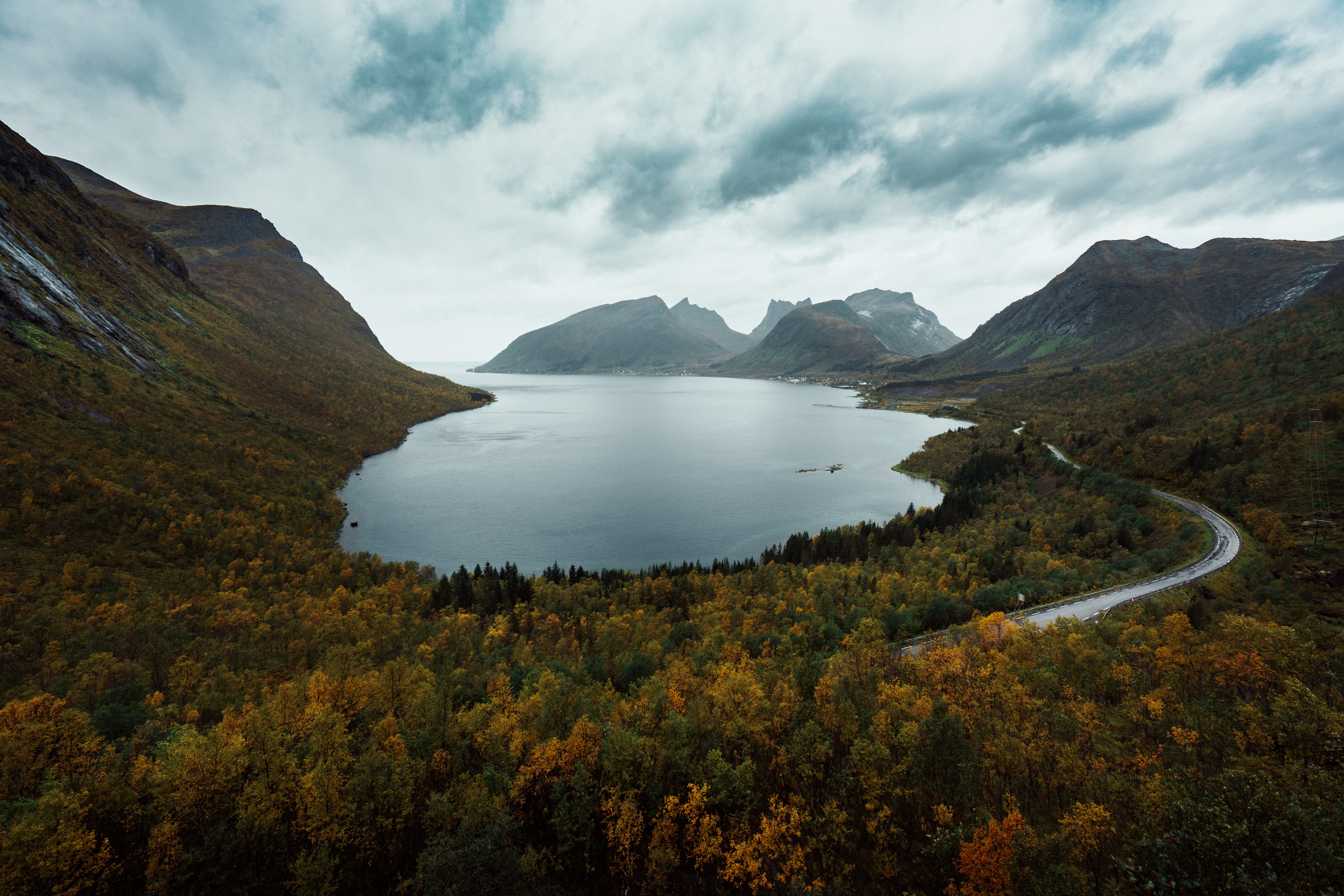
October is an ideal time if you like to spend your vacation without the worry of standing in line for more hours. With lesser crowds, cheaper tickets and easy access all around the country, October is the best to endorse the beauty of Norway. While on the one side, it is true that many of the attractions will be closed. But that doesn’t mean all. There are some of the best places to admire and relish.
Start with Oslo (Norwegian Capital) to look around spectacular museums and monuments that showcase Norway’s historical and cultural significance. While Tromso, Lofoten, Norland and more islands are must-visit in the fall season to experience more adventure, visit Bergen to witness the mindblowing museums and art galleries. Besides, Bergen is also a magical door to glance at the majestic fjords like Sognefjord, Nordfjord and Hardangerfjord. Visiting Geirangerfjord is mandatory in October to marvel at Norway’s natural wonders.
Also Read: 10 Most Beautiful Islands In Norway: Spellbinding Beauty!
Things To Do In Norway In October
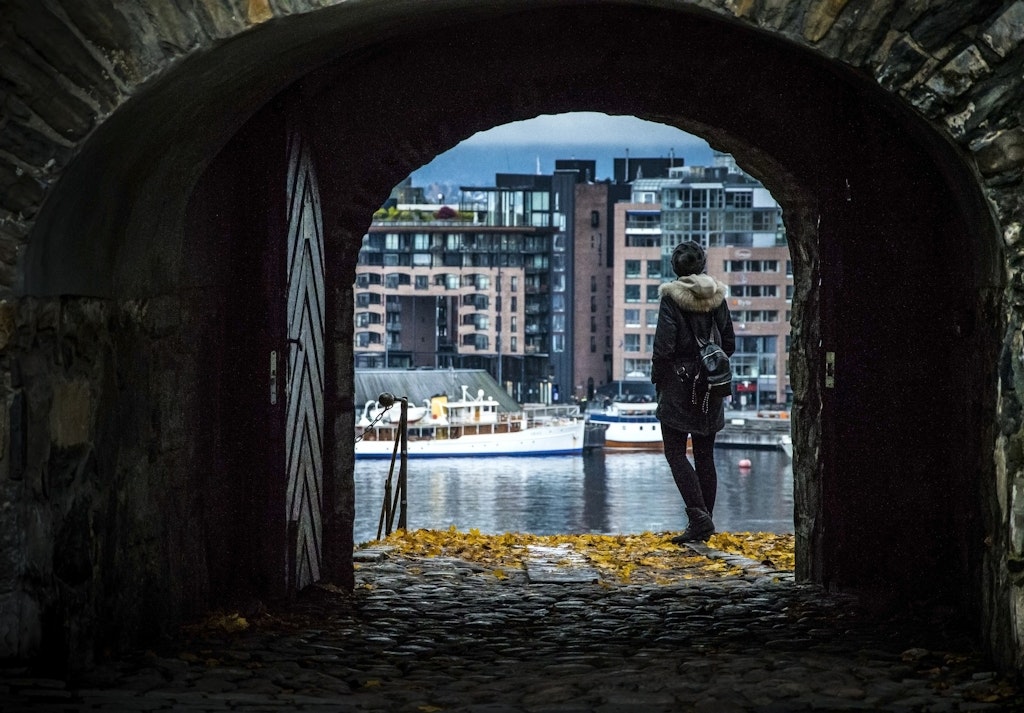
October is the right time to explore the city museums, galleries and monuments a bit closer. Many many beautifully constructed museums in Norway outdate the generic museums we usually see. Take guided walking tours to witness old legendary museums, temples and monuments showcasing the Viking pride to explore without crowds. Undoubtedly, Norway is also the right place with perfect trails, where you can get into an extreme adventure by hiking, skiing and cycling.
The coastal beaches near Oslofjord, Lofoten islands also offer you to partake in mind-blowing water sports. Besides, Byren and Grunerlokka also have quirky neighbourhoods dotted with beautiful restaurants and cafes to dine and socialise. The final thing to do is, capture the stunning colour palette of fall in Norway during October by taking photographs and reels that beautify your Instagram feed.
Also Read: Norway in June
Festivals To Partake In Norway In October
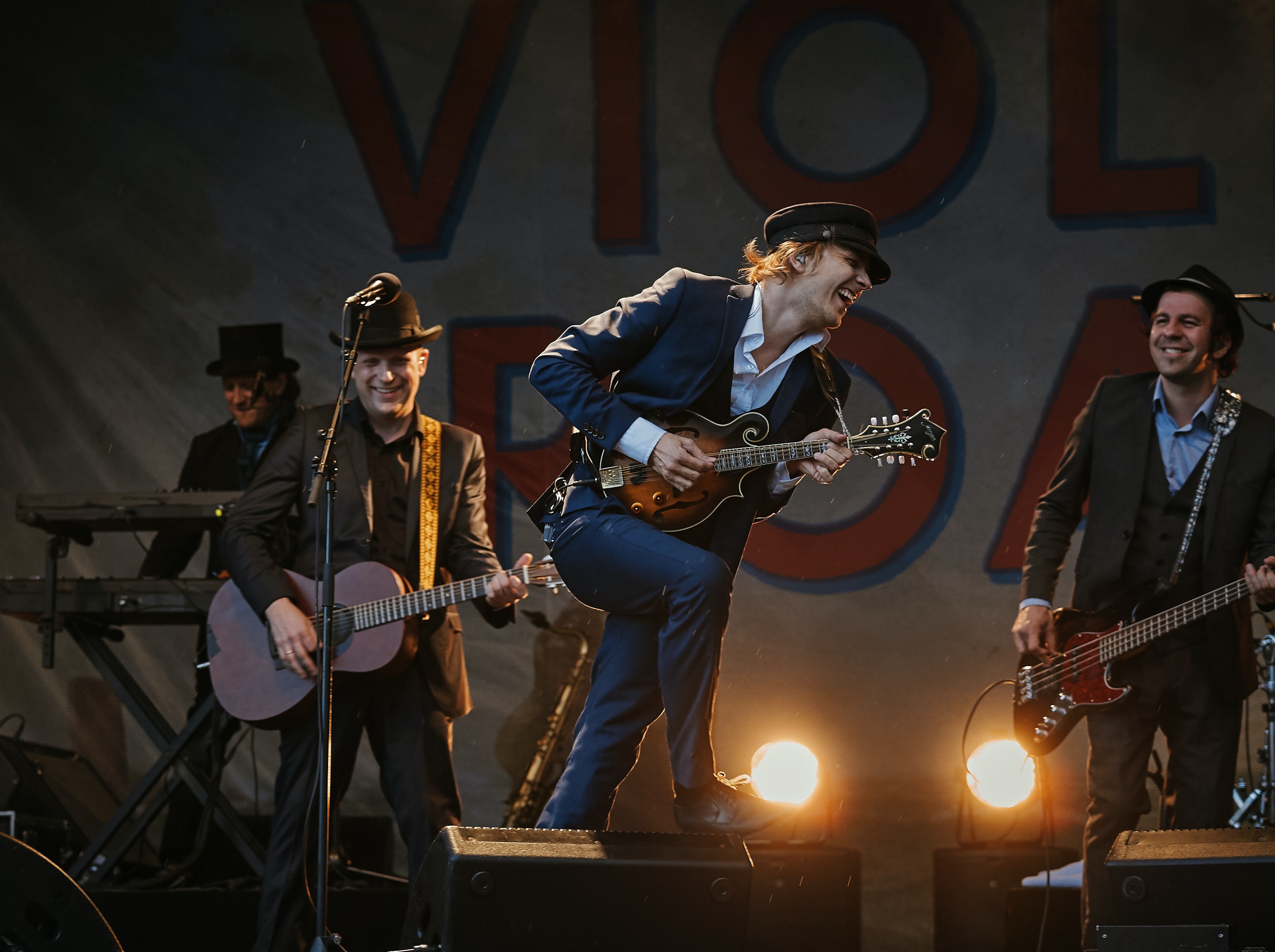
Norway has so many local festivals, events and concerts where you can barge into and get the most memorable experiences you ever wanted. There are few popular events that you need to consider partaking in during your October trip to Norway.
- Bergen International Film Festival: Bergen is the film-enthusiasts paradise. Undoubtedly, Bergen International Film Festival is the most renowned film festival in entire Norway. You can see the city’s significant venues transforming into movie hubs where famous cinemas are displayed with subtitles starting from mid-October till the month-end.
- Dark Season Blues: As the polar nights extend during October end, the Norwegians celebrate Dark Season Blues festival that gives light and energetic vibes to the people. Partake in this music festival hosted by Longyearbyen. Lose yourself with the locals dancing to the beats of concerts and jams.
- Insomnia Festival: Tromso in October is all about the Insomnia music festival. This northmost city will be lit by the spirit of music, especially EDM music that extend over a weekend.
- UKA: October is also the right time to involve in Norway’s most awaited cultural festival that goes up to 3 weeks. Preceded by Trondheim’s University students, the event showcases talents that bring fun and party vibes to the country. It is not an annual festival. It takes place in every odd-numbered year that makes it even more expected.
- Lillehammer Jazz Festival: This is the last Jazz music festival of the year for the Norwegians that steals the spotlight in October for over four days. The fall season and Jazz music sync together to give perfect vibes in the ski village, Lillehammer.
Also Read: Top 5 Things to Do in Drammen
Tips For Your Trip To Norway In October
- Make sure to pack warm clothing along with some lighter clothes in case the weather turns warm.
- Carry some winter gear, shoes, boots, waterproof coats and an umbrella to handle snow and rain showers at certain places.
- As the pandemic is still in the picture, follow Norway’s safety protocol.
- Make sure you are vaccinated using WHO authorised vaccines and carry the certificate(either digital or hardcopy) along with you.
- Don’t forget to cross-check the list of sights that are closed for visitors to avoid mishaps and disappointments.
Also Read: Norway In August
Frequently Asked Questions For Norway In October
Farikal, Lingonberries, Brunost, Luttefisk, Torrfisk, Norwegian Waffles and Sodd are some of the traditional foods in Norway that you must try in October.
Grand Hotel Oslo, Juvet Landscape Hotel, Storfjord Hotel, Hotel Continental Oslo, Farris Bad Hotel and Hotel Union are some of the top luxury hotels to book your stay in October.
Yes, October will be a perfect time to visit if you want to enjoy the beauty of Norwegian fall for cheap and without crowd with your family, partner or all by yourself.
As we have reached the end of this short guide that helps you out for an ideal vacation in Norway in October, it’s time for you to make plans for October 2024. Explore the vast Nordic cities and islands comfortably. Start making your plans with Pickyoutrail at the earliest for a hassle-free vacation. There are different Norway holiday packages from which you can choose. Besides, you can also customise the Norway itinerary.
Nivethitha Bharathi
54 posts published., related itineraries.
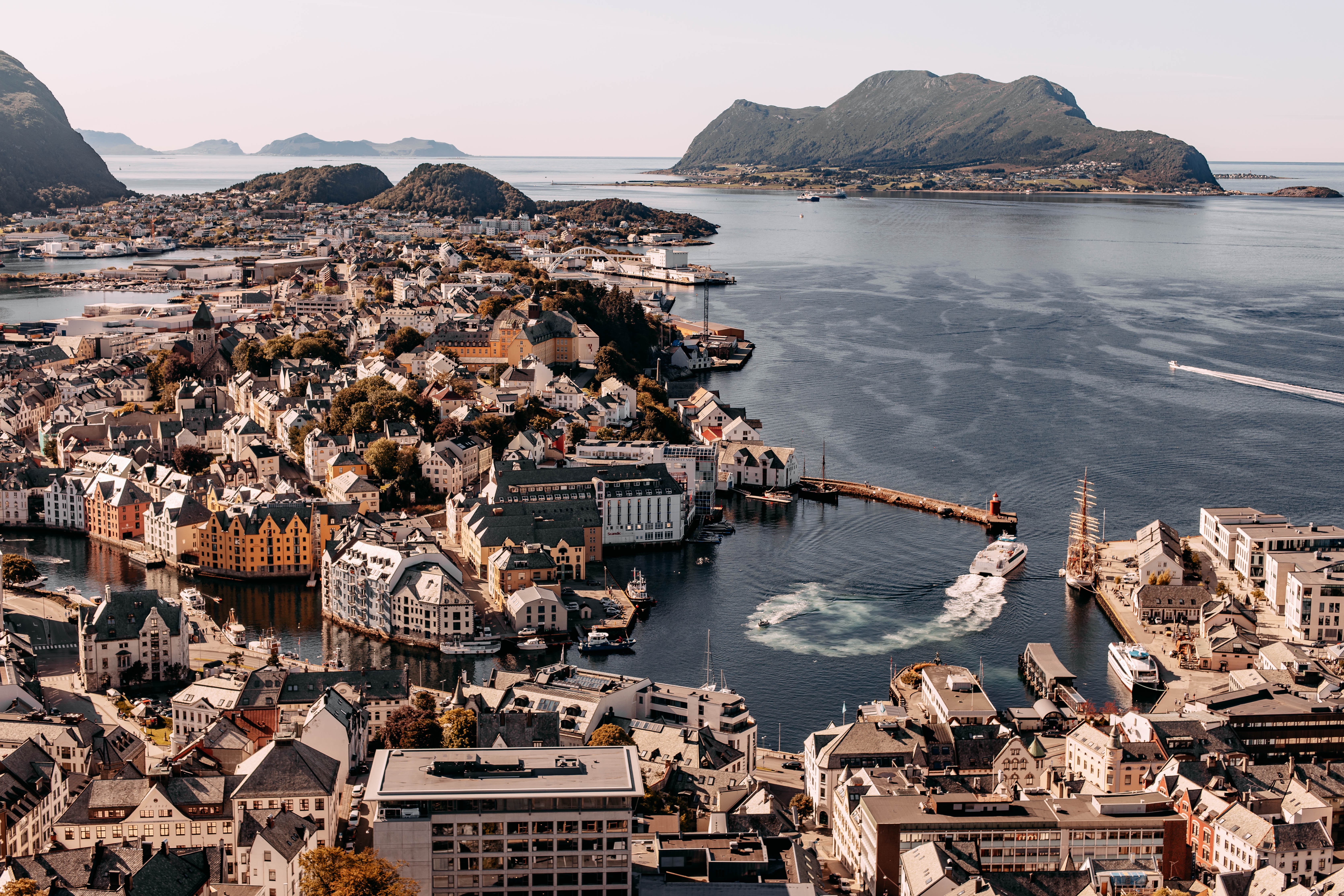
Ultimate 10-Night Norway Adventure: Best Itinerary for Unforgettable Exploration
- Flights excluded
- 4 star accommodations
- 5 activities
- Shared transfer
₹ 3,18,862
Starting price/person
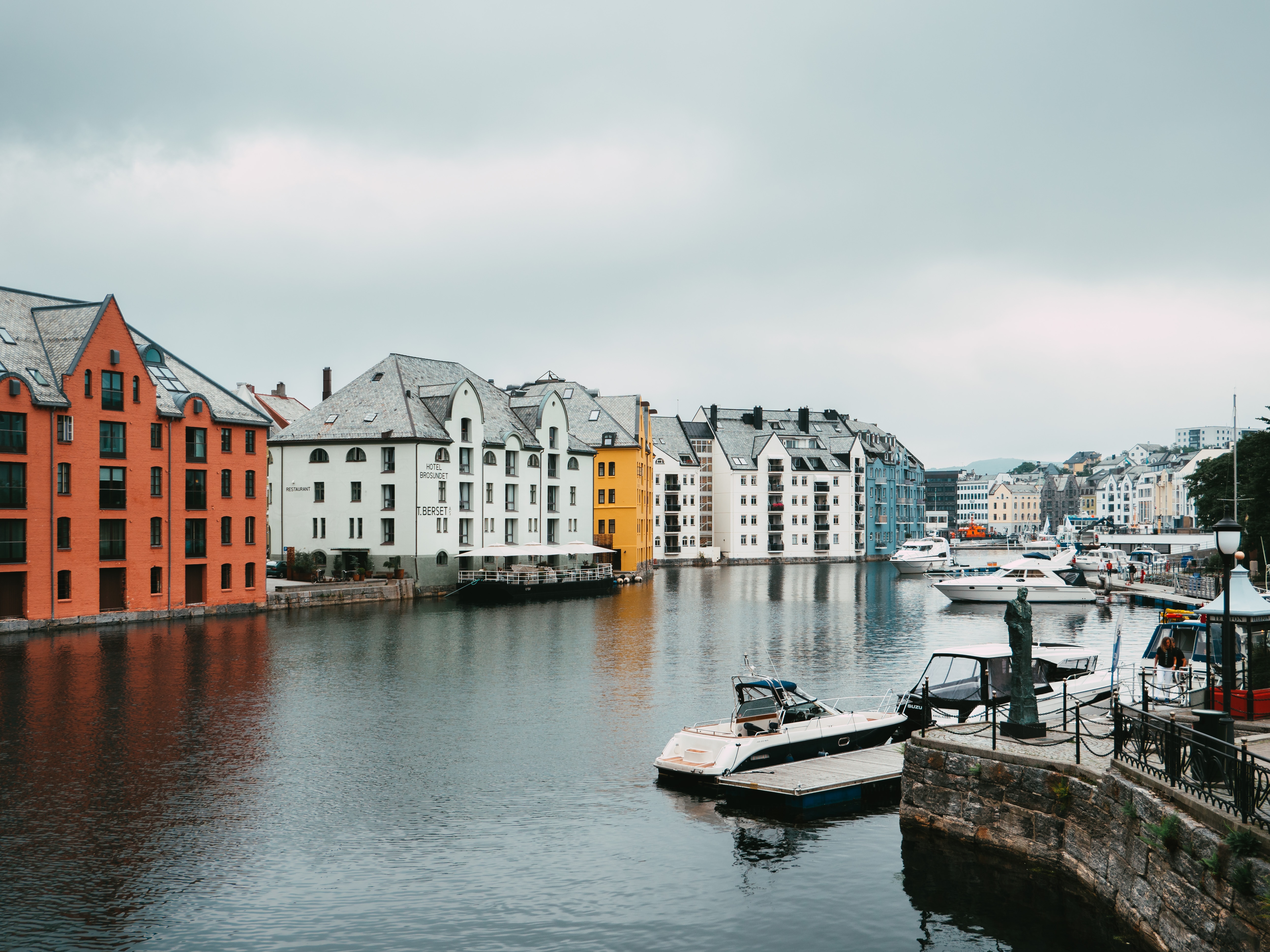
Tranquil Norway Escape: 10-Day Relaxing Tour Package
- 4 activities
- Private transfer
₹ 2,48,633

Scenic Sweden Norway Getaway: 7-Night Postcard-Perfect Vacation Packages
- 3 activities
₹ 1,90,704
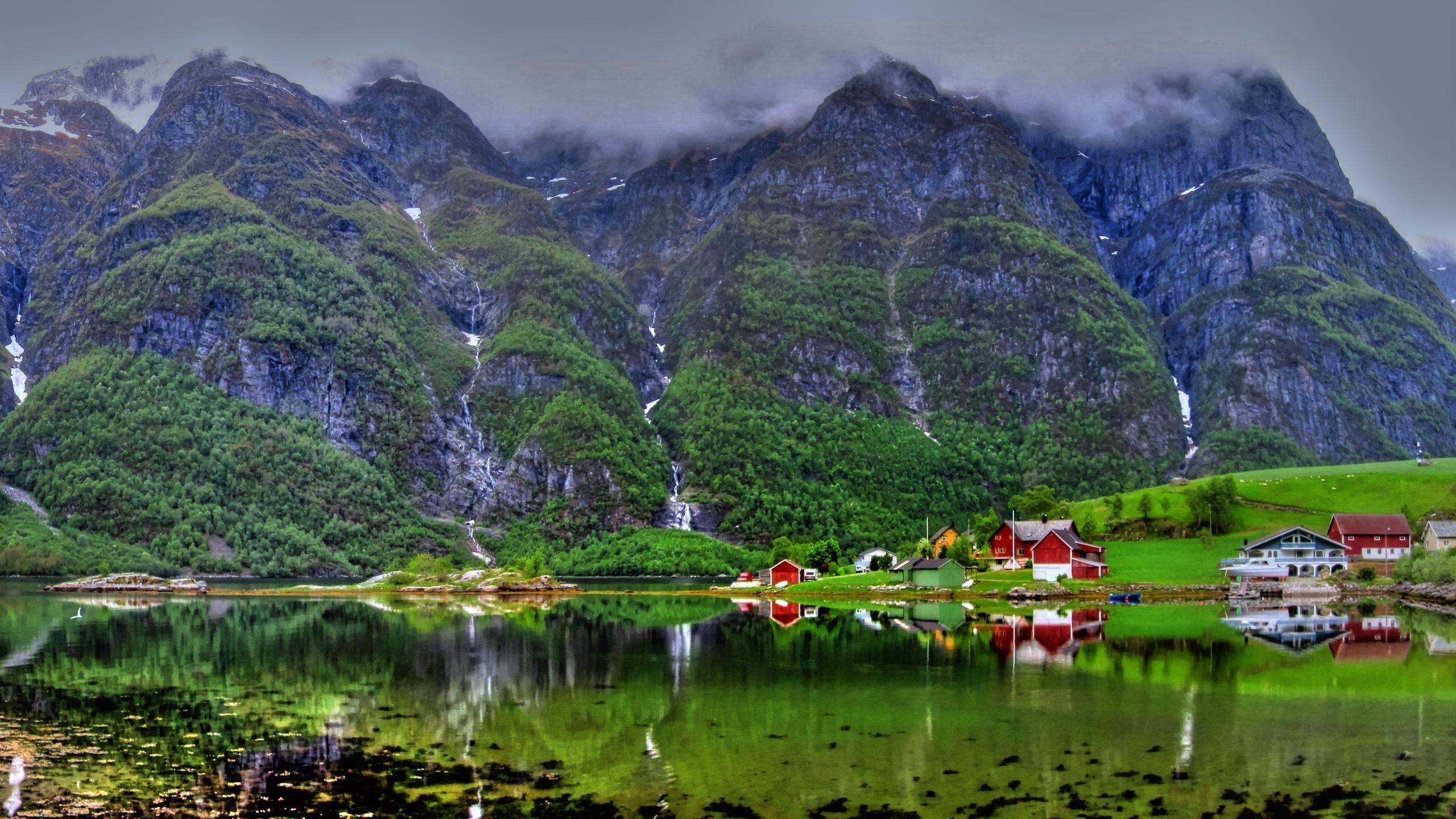
Unforgettable Oslo Norway Escape: 8-Night Vacation Packages
₹ 1,71,051.
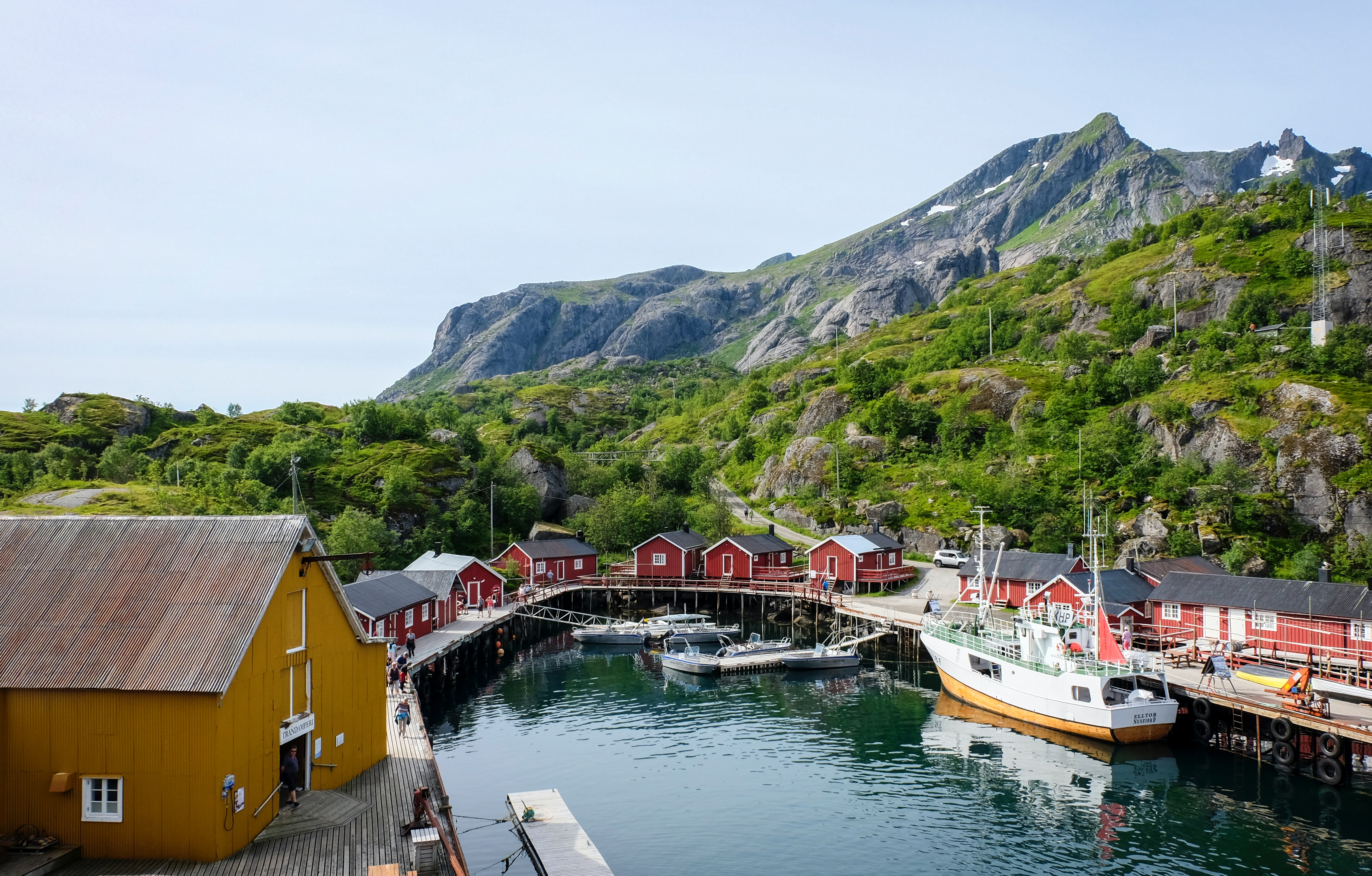
Splendid Norway Getaway: 5-Day Trip Package from India
₹ 1,41,753.
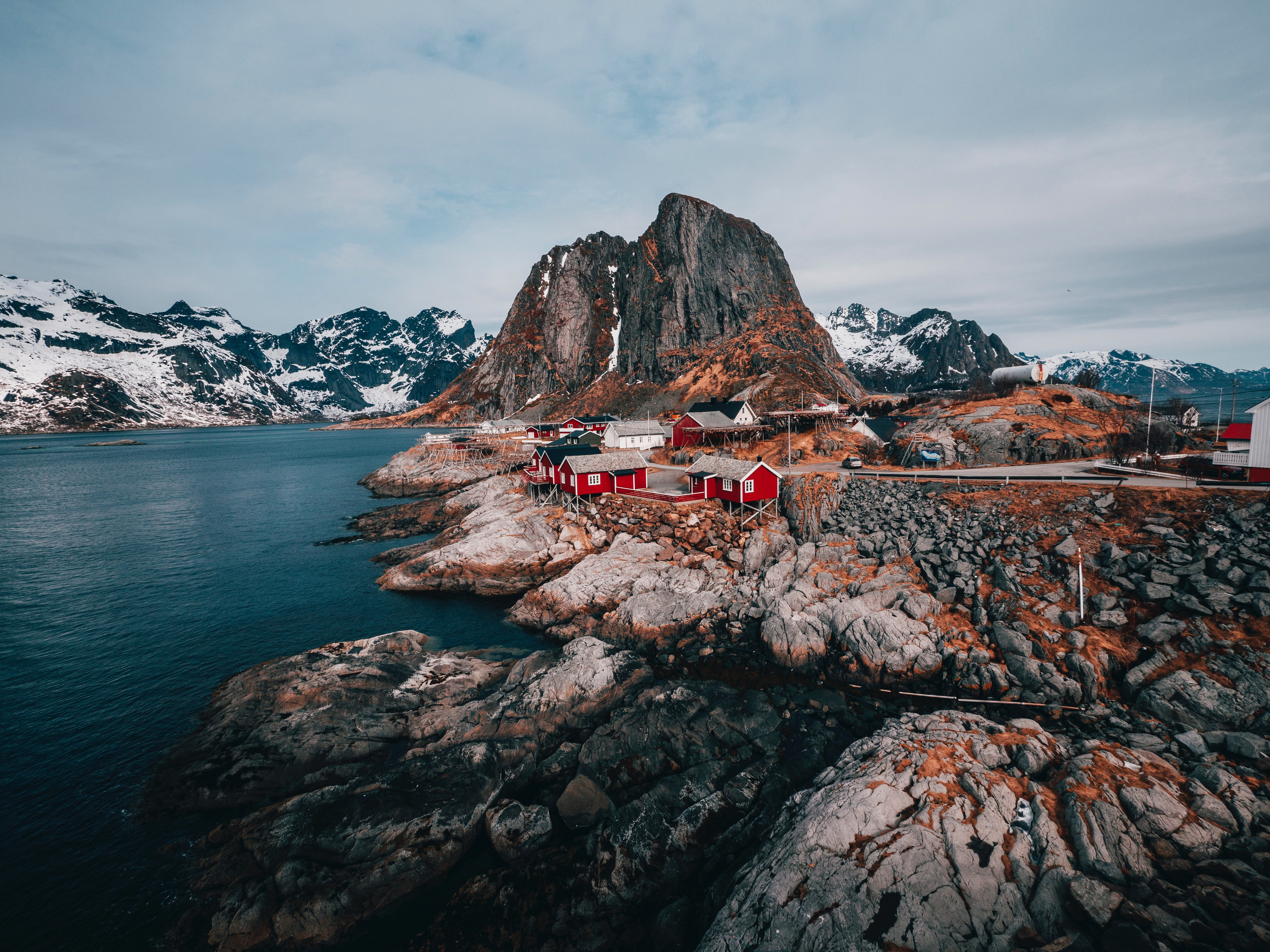
Astounding Norway Experience: 6-Night Tourism Package from India
₹ 1,76,347.

Enchanting Nordic Journey: 11-Night Norway Sweden Finland Tour Package
₹ 2,08,633.

Unforgettable Norway Holiday: 12-Night Best Selling Package from India
₹ 2,25,464.
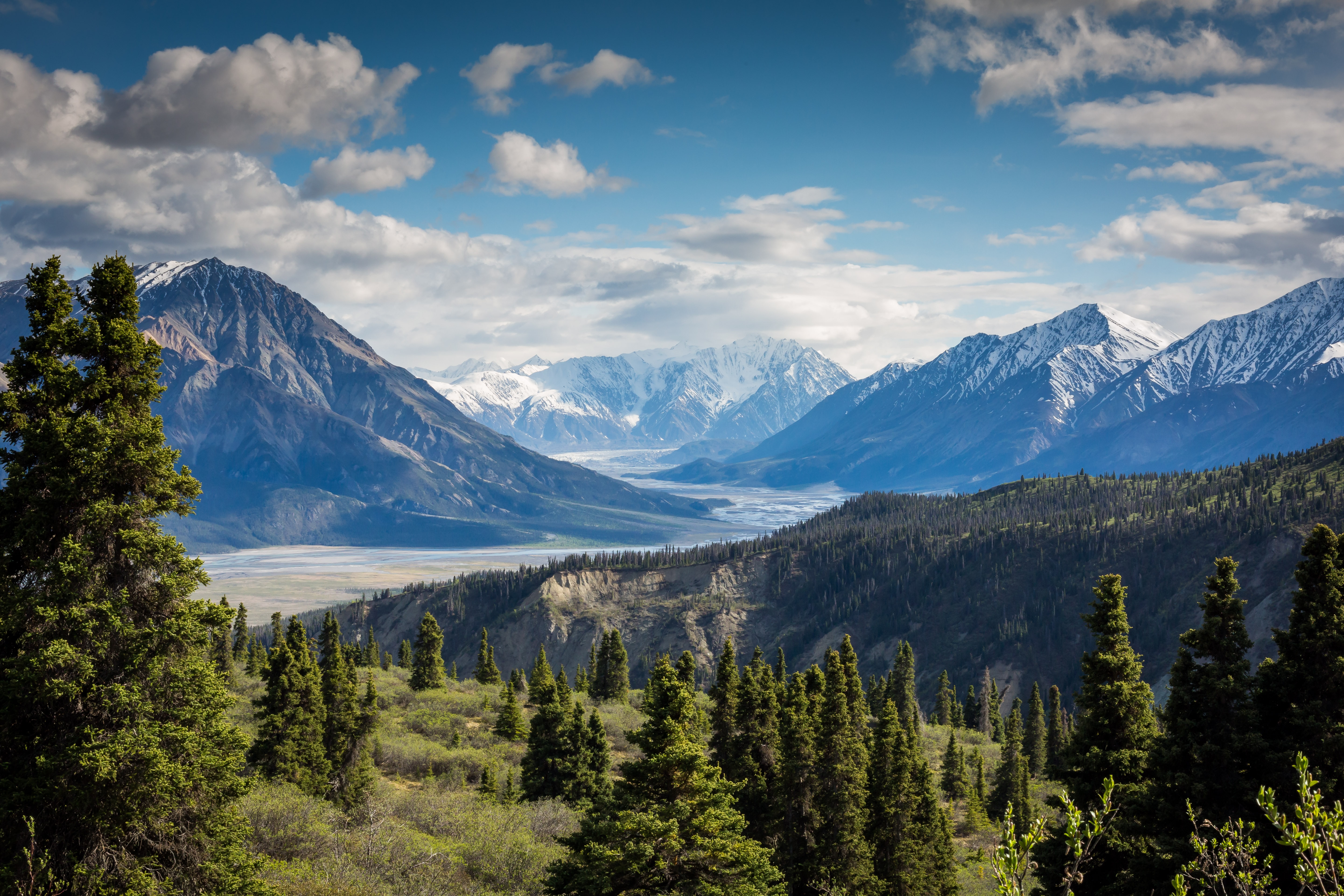
Captivating Northern Lights Adventure: 6-Night Exclusive Norway Packages
- 3.5 star accommodations
₹ 2,02,445
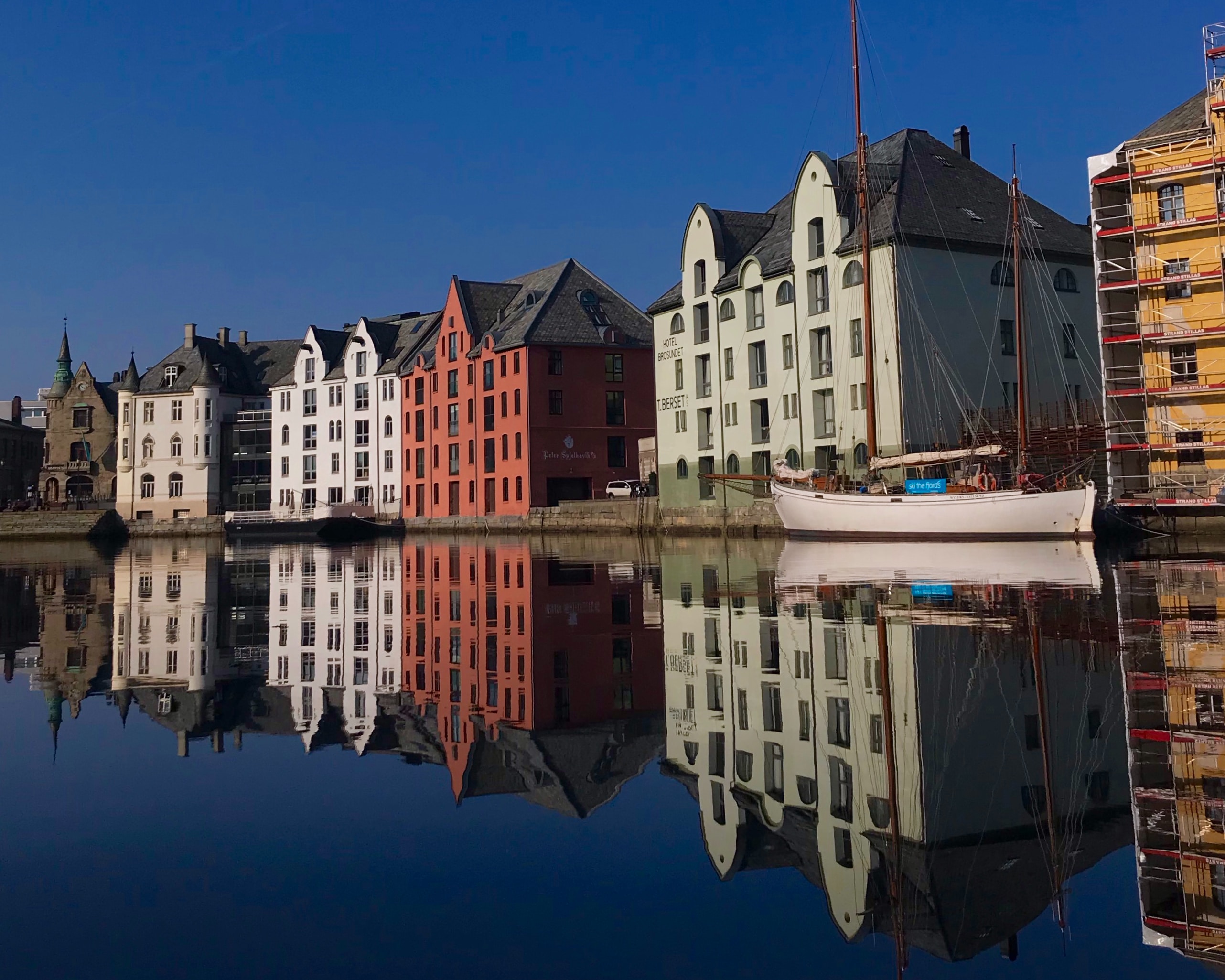
Enigmatic India to Norway Expedition: 10-Night Package
₹ 2,10,933, related posts, 10 best indian restaurants in norway, 9 most breathtakingly beautiful european villages to visit in 2024, 9 most scenic train rides in europe to experience in 2024, norway in november: a perfect norway trip, norway in august – a helpful and handy guide for a hassle – free planning, 7 scintillating norway adventures that will change the way you look at life, europe in may – a complete guide, 10 best national parks in norway, 10 best lakes in norway, 10 best trekking places in norway, norway in may, norway in february guide to have a perfect trip.
Book a vacation completely online
Our community is growing fast
Sign up for exclusive PYT Club membership and access jaw-dropping deals before the rest of the world!
- Signup with Email
- Facebook community
- Telegram Community
Access exciting travel deals at best prices
- New Zealand
- South East Asia
- United Kingdom
- United States
- Switzerland
- Travelogues
- Travel News
- Guest Posts
- Write for us
Global Energy Perspective 2023: Energy value pools outlook
The Global Energy Perspective 2023 models the outlook for demand and supply of energy commodities across a 1.5°C pathway, aligned with the Paris Agreement, and four bottom-up energy transition scenarios. These energy transition scenarios examine outcomes ranging from warming of 1.6°C to 2.9°C by 2100 (scenario descriptions outlined below in sidebar “About the Global Energy Perspective 2023”). These wide-ranging scenarios sketch a range of outcomes based on varying underlying assumptions—for example, about the pace of technological progress and the level of policy enforcement. The scenarios are shaped by more than 400 drivers across sectors, technologies, policies, costs, and fuels, and serve as a fact base to inform decision makers on the challenges to be overcome to enable the energy transition. In this article, we examine integrated energy and pricing value pools and their outlook.
About the authors
This article is a collaborative effort by Marco Bevilacqua, Tamara Grünewald, Sebastian Overlack, Ole Rolser , Anna Schrum, and Christian Therkelsen , summarizing sector perspectives from across McKinsey and McKinsey Energy Solutions.
Growing global momentum is accelerating the energy transition. This was recently evidenced by the UAE Consensus, delivered at COP28 on December 13, 2023, that called on Parties to implement several key steps: triple renewable energy capacity globally and double the global average annual rate of energy efficiency improvements by 2030; accelerate efforts toward the phase-down of unabated coal power; accelerate efforts globally toward net zero emission energy systems by utilizing zero- and low-carbon fuels well before or around mid-century; and transition away from fossil fuels in energy systems in a just, orderly, and equitable manner and accelerate action in this critical decade to achieve net zero by 2050.
Recognizing the advancing transition could see a positive shift in market competitiveness for renewables as they are scaled up and unabated fossil fuels are scaled down. This perspective considers how developments in the past 24 months have led to a shift in the discussion on energy value pools, with industrial competitiveness being a key incentive and driver for the energy transition.
About the Global Energy Perspective 2023
Recent developments have deeply impacted the global energy system and have highlighted accelerators and challenges for the energy transition, including:
- a renewed focus on affordability, reliability, and industrial competitiveness alongside emissions reduction;
- variability across countries and regions on energy system modernization and which technologies will lead; and
- an increased awareness of the key bottlenecks , including critical materials and land shortages, that could impact the shape of the transition.
Transition accelerators that have emerged mostly relate to current government support and investment momentum in low-carbon technologies. The latest government initiatives that aim to support the energy transition, such as the Inflation Reduction Act (IRA) in the United States, the European Union’s Green Deal Industrial Plan, and Japan’s green transformation plan, aim to act as growth triggers for low-carbon investments and technologies.
The uptake of low-carbon technologies, including heat pumps and electric vehicles (EVs), continued to accelerate in 2022, and multiple low-carbon technologies are becoming increasingly efficient. 1 World Energy Outlook 2023 , International Energy Agency, October 2023. The last two years have seen record investments into the energy transition, reaching around $1.8 trillion in 2022. 2 World Energy Outlook 2023 , International Energy Agency, October 2023. Lastly, there have been continued commitments and investment decisions toward net zero by major industrial players, in, for example, the automotive, oil and gas, materials, and financial sectors, though more will be needed. 3 McKinsey analysis.
Transition challenges include increasing costs throughout the energy system following the European energy crisis, cost inflation on many renewable projects, affordability challenges, slower-than-expected realization of some low-carbon projects, such as green hydrogen projects, and, as a result, shifts in societal sentiment around renewable projects, and ongoing fossil fuel demand. Analysis from multiple sources, including the IEA, IPCC, and McKinsey, suggest that conventional fossil fuels are likely to remain a part of the energy mix to 2050, even in a 1.5° scenario, and may act as a bridge for an orderly transition. Renewable projects have seen cost increases for the first time in more than 20 years due to rising raw material costs and increasing interest rates. 4 WindEurope Intelligence Platform. There has been pipeline uncertainty for new wind, hydrogen, and carbon capture, utilization, and storage (CCUS) projects. Only 10 gigawatts (GW) of wind projects have been financed in the European Union over the last 24 months, falling short of the 30 GW per year needed to meet climate commitments, and only 9 percent of hydrogen projects reached final investment decisions (FIDs). 5 McKinsey Energy Solutions’ Global Energy Perspective 2023 , McKinsey, November 21, 2023. Coal (the most carbon-intensive fuel source without CCUS) is expected to be phased out gradually. Coal demand is projected to decrease by between 25 and 85 percent between 2019 and 2050 depending on the scenario, driven mainly by the phaseout of coal plants in the power sector across regions. 6 McKinsey Energy Solutions’ Global Energy Perspective 2023 , McKinsey, November 21, 2023.
Across scenarios, total energy-sector investments are projected to grow but to remain in line with historical shares of GDP
Total annual investments in the energy sector are projected to grow by up to 4 percent per annum until 2040, reaching between $2.0 trillion and $3.2 trillion.
Decarbonization technologies are projected to show the highest growth in investments at 6 to 11 percent per annum, driven by strong uptake of EV charging infrastructure (EVCI) and CCUS. The EVCI market for hardware components is projected to reach between $17 billion and $35 billion by 2030, representing a growth of at least 10 percent per annum. 1 McKinsey Energy Solutions’ Global Energy Perspective 2023 , McKinsey, November 21, 2023.
While the overall shift toward more capex-intensive technologies, such as renewables, means higher investments are expected in faster energy transition scenarios, these are projected to be mostly offset by the lower total operating expenditure of renewable assets, such as saving the fuel costs that fossil plants require.
Going forward, there is projected to be a substantial shift in investment from fossil fuels to renewables. However, despite the increasing push for decarbonization and the declining demand for fossil fuels projected in the medium term, around 20 to 40 percent of investments (excluding power T&D) 2 Transmission and distribution. in 2040 are projected to still be deployed in fossil fuels, across all scenarios. As such, a further shift in investments would be needed for a 1.5° pathway.
Even with lower projected volumes of oil or gas for power generation, continued investment in fossil fuels is mainly driven by the fact that marginal fossil fuel projects are increasingly expensive with higher development costs, and will still see significant investment, while marginal costs and capex for low-carbon technologies continue to decline with technological learning curves.
Investment into low-carbon technologies is projected to overtake fossil fuels by 2025
Investments in low-carbon technologies are projected to outpace fossil fuels before the end of the decade, building on current momentum, investor appetite, and government support as 2030 targets come closer.
As demand growth flattens, overall investment in fossil fuels is projected to gradually decline starting the second half of this decade, although fossil fuels are expected to remain part of the energy mix even in the faster energy transition scenarios. Investments in low-carbon technologies and power T&D show a significantly wider range of uncertainty between scenarios. This is partially driven by uncertainties surrounding implementation and varies significantly between markets and even between different regions within the same country. In particular, increasing generation from intermittent renewables may require a stronger uptake in grid build-out.
Government support could play a critical role for building global momentum by improving low-carbon economics via subsidies and incentives and by setting specific deployment targets between 2025 and 2030. For example, in the United States, the IRA plans to expand wind and solar capacity by 250 GW and 475 GW, respectively, until 2030, REPowerEU aims to increase renewables capacity in the European Union by up to 42.5 percent by 2030, and China’s 14th Five-Year Plan is designed to achieve 3.3 terawatt hour (TWh) annual renewable energy generation by 2025, up from 2.2 TWh in 2020. 1 “China releases five-year plan for renewables,” Taiyung News, June 2, 2022; Inflation Reduction Act of 2022, US Congress; “One year of the IRA: Tailwind for the energy transition,” en:former, October 16, 2023; “REPowerEU at a glance,” European Commission.
Cumulative investment is $20 trillion higher in the Achieved Commitments scenario than Fading Momentum
Cumulative investments by 2040 are projected to vary significantly between scenarios, with around $20 trillion more investments expected in the Achieved Commitments scenario than in the Fading Momentum scenario. This is due to the higher investments in power renewables, power T&D, and decarbonization technologies in the Achieved Commitments scenario.
Slower scenarios are projected to see higher investments in oil and gas due to lower decarbonization ambitions and limited incentives to advance clean energy supplies. On the other hand, capital spending for conventional power is expected to be higher in faster scenarios due to projected higher electricity demand, and as the uptake in renewables requires additional conventional capacity for flexible generation.
Low-carbon technologies could see EBIT growth between 2.0 and 3.5 times by 2040, compared to 2021
Global EBIT 1 Earnings before interest and taxes, a common metric used to compare profits across different geographies and operating models. in the energy sector is expected to stabilize at around $1.6 trillion to $2.0 trillion by 2040.
EBIT for low-carbon technologies is projected to see growth of 3 to 8 percent CAGR until 2040, mostly driven by strong volumes uptake. Nonetheless, margins are expected to remain tight due to strong competition in the market.
By the end of the decade, a decline in EBIT from fossil fuels is projected, resulting in a total pool of $1.5 trillion to $1.9 trillion. Nonetheless, after 2030, the decline may be partially offset by significant EBIT growth from low-carbon technologies (a growth between 2.0 and 3.5 times by 2040 compared to 2021).
EBIT for fossil fuels is projected to stabilize at different levels in the long term, at around $1.4 trillion by the end of the next decade in the Fading Momentum scenario compared to $0.4 trillion in the Achieved Commitments scenario.
As local energy production grows, EBIT pools are projected to move from oil and gas suppliers toward demand centers
Total global EBIT is expected to remain constant or to decline slightly in all regions at between 0 and –2 percent CAGR, except in India, where a yearly growth of 6.7 percent per annum is projected, mostly driven by a more than tenfold growth in power renewables, and in the Commonwealth of Independent States (CIS), where a projected 6 percent decline of the EBIT pool is mostly driven by a large decline in oil and gas production. Overall, EBIT value pools are expected to become more geographically distributed, moving from supply to demand centers as most low-carbon technologies favor or even require local energy supply rather than global trade.
Major fossil-producing regions, such as the Middle East and Africa (MEA) and North America, are expected to remain among the regions with the largest EBIT value pools by 2040 as growing profits from low-carbon technologies offset profits from fossil fuels.
By 2040, renewables are projected to become the single largest source of EBIT across most regions, except for MEA and the CIS, where around 85 percent and 60 percent, respectively, of the pool is still expected to remain fossil based.
To manage a system which is moving more toward fixed costs, updates to power market designs may be needed
In most markets today, conventional assets (such as coal, gas, oil, nuclear, and hydro) provide energy in the market as well as firming capacity. With the further expected growth in solar and wind capacity, the role of conventional plants may be decoupled, moving from providing both the primary source of energy and firm capacity to largely providing firming and flexibility in the system. As a marginal market price is projected to correlate with short-run marginal costs across the system, additional remuneration could be needed for asset types to remain profitable to enable their continued operation and especially to fund the technologies required to abate emissions from these operations. By 2040, up to 15 percent of revenues from nuclear assets, 50 percent of revenues from gas assets, and 65 percent of revenues from coal assets may need to come from market mechanisms other than marginal energy production payments for these technologies to remain viable in order to meet remaining transition demand.
Renewable assets with fixed (non-dispatchable) outputs may be subject to correlation effects that drive down prices during periods of high wind and solar production. This will tend to decrease the capture price of those technologies, where variable prices no longer link to total lifecycle cost of production. Out-of-market payments, such as contracts for difference or power purchase agreements, which often include renewable energy certificates which show that a given plant produces renewable power, will likely continue to be needed to secure financing.
Dispatchable thermal capacity, such as gas plants, are more likely to maintain positive returns in geographies with lower fuel costs, such as in the United States. Similarly, clean technologies, such as CCUS, are expected to leverage a variety of market payments as well as support initiatives to maintain profitability.
Regarding older conventional technologies, coal is likely to be largely retired in the near future, while other unabated carbon-emitting technologies will likely run less frequently than they do at present. Nevertheless, as renewable power is ramped up, managing conventional technologies still in use to minimize their environmental impact could be an important concern.
Revenue mechanisms could include capacity markets and payments, subsidies, regulated prices, active markets for clean energy certificates, and contracts for difference to limit uncertainty. Some of these mechanisms already exist in markets globally.
Only certain renewables match strong growth with high EBIT pools
To examine the projected market growth and potential EBIT pools of specific technologies, the projections of the Current Trajectory scenario were used, but note that these may differ significantly across scenarios. Overall, for the Current Trajectory scenario, power renewables and decarbonization technologies are projected to see the highest market growth (most between 2 and 9 percent per annum) as a result of strong demand uptake across all scenarios.
Long-term EBIT projections vary significantly between technologies. The largest value pools are expected to be oil upstream, liquified natural gas (LNG), and wind onshore, with profits above $200 billion in 2040. The other segments are projected to remain below $100 billion per annum by 2040.
Certain renewable technologies could provide high margins thanks to additional revenue streams such as capacity payments and storage (such as pumped hydro).
Strong profitability and market growth do not directly imply high attractiveness of the segment due to market barriers such as strong competition or critical core capabilities needed to succeed.
To request access to the data and analytics related to our Energy value pools outlook, or to speak to our team, please contact us .
Marco Bevilacqua is a consultant in McKinsey’s Amsterdam office, where Ole Rolser is a partner; Tamara Grünewald is an associate partner in the Zurich office, where Anna Schrum is a consultant; Sebastian Overlack is a partner in the Frankfurt office; and Christian Therkelsen is a partner in the Oslo office.
Explore a career with us

IMAGES
COMMENTS
What's on in Oslo - Event calendar. Find out what's happening in the Norwegian capital, from festivals and concerts to exhibitions and sports. Browse the categories or search by date, keyword or location. Discover the best events for your visit to Oslo.
The weather in Oslo in October. Oslo is the biggest city (as well as the capital) of Norway, and attracts hundreds of thousands of tourists every month, even in the off-season in October. ... October is a great time to visit the Norwegian fjords, and you will be surprised by it's late autumn beauty.
The average fall temperature is +12C, but it begins to get even colder as October approaches. There's no doubt that some of the most beautiful months in Oslo, Norway, are September and October, when the sky often glows in warm hues, the air is crisp, and leaves start to turn yellow.
October is a good time to visit Oslo. The weather is usually cold, humid but cool, with temperatures ranging from 36—47°F (2—8°C). There are plenty of events to check out and activities to try in Oslo during this time. Some of our top recommendations: visit the Norwegian Museum of Cultural History and explore the open-air museum in the ...
Trondheim. Another great place to visit during October in Norway is Trondheim, the country's third-largest city. One of the things that makes Trondheim great during October is that the university students are actively in school for most of the month and it adds so much to the life of the city. Trondheim autumn colors.
Best Times To Visit Oslo. The best time to visit Oslo is from May to August when the temperatures rise and there are surprisingly affordable room rates available, though these options often fill ...
The best weather in Oslo is arguably from late spring to early autumn, particularly between June and August, when temperatures range comfortably from 18°C to 25°C. These months allow for a wide range of outdoor activities, from hiking in the nearby forests to swimming in the Oslofjord. Spring (April to May) and autumn (September to October ...
In October, Oslo is relatively uncrowded so one can go out and enjoy some fresh air while spending time in places like Vigeland Sculpture Park or exploring Oslo's Akerselva River Walk—a scenic 5-mile waterway with forests, wildlife, museums, and local history. ... Visit them on 11th, 12th, 17th and 19th October for a day party. ...
Get to know the city on a sightseeing tour or with a guide. You can hop on a sightseeing bus or boat or take part in museum tours. With the Oslo Pass, you get a discount on sightseeing as well as free admission to more than 30 museums and attractions. Get more inspiration on Oslo's official website. visitoslo.com.
Why you should visit Oslo in October October is a fantastic time to visit Oslo, as the city is adorned with the stunning colors of autumn. The weather is crisp and cool, perfect for exploring the city's outdoor attractions. Additionally, October sees fewer tourists than the summer months, allowing for a more relaxed and authentic
For anyone interested in such, its panels and events make it a good time to visit. For me, having spent six years in Scandinavia, and long summers and winters in Norway, Oslo became a base for ...
Experience a fjord-side sauna. Finnish sauna culture has been adopted by Oslo over the last 10 years or so and has become a popular thing to do on the harborside. Dress in swimwear and take a seat on a bench in a paneled room that's heated to 80-95°C (176-200°F) by a wood-burning stove. A towel is recommended to stop an uncomfortable burn ...
Weather. Summer can feel like a distant memory by the time October rolls around with crisp, cool air, and shorter daylight hours. In the south, the temperatures usually fall between 40-50 degrees Fahrenheit, while the northern reaches of the country can be much colder. Depending on where you travel, you may experience changing seasons from fall ...
August-October is among the most beautiful months in Oslo, with crisp air and beautiful autumn colors of yellow, orange, and red. Below a list of things to do in Oslo during the fall season: Hiking to Grefsenkollen, Vettakollen, or in Nordmarka; Visit the Botanical Garden, especially in September when the flowers bloom.
Don't plan a summer visit For more affordable airfare and room rates, arrive between October and April, Oslo's coldest months.If you're set on enjoying some warmer weather, try visiting in May or ...
Best time of year to visit Oslo. There are two seasons that could claim to be the best time to visit Oslo: summer with its warm and long days and winter full of Chrismas mood and sports.June-July are perfect months to explore the city, chill in rooftop bars, and hunt for wild berries. Winter comes early to the city and brings Christmas foods, winter sports like skiing and ice skating, and ...
Best time to visit Oslo and things to do during each season. See Oslo's coolest neighborhood and attractions, spend time in museums worth visiting. ... In the last week of September or the first week of October (always week 40), kids in Oslo and the suburbs have a fall vacation, and many families with school kids leave town for a fall break ...
Our guide to highlights in Oslo that you can visit in one day. The day plan is ready for you, with museum visits, transport and restaurants. ... The Bygdøy ferry does not operate from October to February/March. In the autumn and winter season, you must therefore use bus line 30 if you wish to travel to Bygdøy by public transport. ...
Go on a wildlife safari. 10. Northern lights. This magical natural phenomenon has been mesmerising people in Northern Norway for thousands of years. In October, the auroras are getting ready to dance again. Get ready to be mesmerised! Learn all about the northern lights. 11. Workations.
Weather In Norway In October. As Norway welcomes the fall season and bids adieu to summer, the breeze becomes a bit cooler, and the daylight becomes shorter. As Norway is in the Arctic circle, naturally, the temperature in the Northern region turns cold. While in the south, the temperature in Norway takes a dip between 39-50 degrees Fahrenheit.
The Global Energy Perspective 2023 models the outlook for demand and supply of energy commodities across a 1.5°C pathway, aligned with the Paris Agreement, and four bottom-up energy transition scenarios. These energy transition scenarios examine outcomes ranging from warming of 1.6°C to 2.9°C by 2100 (scenario descriptions outlined below in sidebar "About the Global Energy Perspective ...
You can speak with one of our knowledgeable staff members at the official tourist information of Oslo, Oslo Visitor Centre. It is located in the Central Station, in the yellowish building known as Østbanehallen. Address: Jernbanetorget 1, 0154 Oslo. If you are coming from inside the central station, follow the signs that say "Tourist information".
In an interview with Haaretz's Ravit Hecht in December 2016, Smotrich said he intended to apply Israeli sovereignty to the entire West Bank (Areas A, B and C, to use the Oslo Accords' terminology), build five major cities there and bring another 500,000 to a million Jews to live there. But first of all, he added, he intended to win the conflict ...